Beyond a Jobless Recovery:
A heterodox perspective on 21st century economics
Note: This used to be a "Top Viewed" Google Knol with about 12,000 page views (as of January 2012), but as Knol is going away, I moved it to my site.
This article explores the issue of a "Jobless Recovery" mainly from a heterodox economic perspective. It emphasizes the implications of ideas by Marshall Brain and others that improvements in robotics, automation, design, and voluntary social networks are fundamentally changing the structure of the economic landscape. It outlines towards the end four major alternatives to mainstream economic practice (a basic income, a gift economy, stronger local subsistence economies, and resource-based planning). These alternatives could be used in combination to address what, even as far back as 1964, has been described as a breaking "income-through-jobs link". This link between jobs and income is breaking because of the declining value of most paid human labor relative to capital investments in automation and better design. Or, as is now the case, the value of paid human labor like at some newspapers or universities is also declining relative to the output of voluntary social networks such as for digital content production (like represented by this document). It is suggested that we will need to fundamentally reevaluate our economic theories and practices to adjust to these new realities emerging from exponential trends in technology and society.
On sources, most of this content was written and organized by the author, but some resulted from a collaborative process on the Wikipedia Jobless Recovery article, and so the content is licensed similar to Wikipedia. See that article for attributions, although almost all this content was since deleted by advocates of mainstream economic theology. :-) While I tried to cite sources and be as neutral as possible, others disagreed. So, I am presenting this article on Google Knol so these ideas remain easily available to people. I have also added some inline YouTube videos related to the content. The ideas here were also refined indirectly through discussions about related issues on the Open Manufacturing mailing list, the p2presearch mailing list, and the Princeton University TigerNet alumni mailing lists, as well as in other places like Slashdot and various blogs. This article could also be seen as an outgrowth of Google's Project Virgle April Fool's joke which created some social connections (including to people involved with OpenVirgle and Open Manufacturing) and also inspired me to start putting up more content related to post-scarcity and social/technical change issues.
Authors
A jobless recovery or jobless growth is a phrase used
by economists, especially in the United States, to
describe the recovery from a recession, where "recovery" is defined as growth in
gross domestic product (GDP),
which does not produce strong growth in employment, specifically a rapid drop in the
unemployment rate to the level it was prior to recession. The first
documented use of the term was in the New York Times in the
1930s.[1]
A jobless recovery is usually seen as a bad thing in a
capitalist industrialized society. This is primarily because in
such a society most people need jobs to earn the money they need to
purchase goods and services from the marketplace. Also,
secondarily, doing something useful and productive is usually
connected to a healthy individual's self-esteem and his or her positive relationships
to the larger community. An alternative view is that a jobless
recovery could be a step towards a post-scarcity society full of abundance for
all -- as a new stage of cultural development with
increased leisure and volunteerism. That alternative view represents a
trend that many technologists, futurists, and heterodox economists
have predicted for decades. Marshall Brain recently gave a related
talk, available here.
Some economists have suggested that increasingly better automation (including AI and robotics), better design, better materials, and better communications are together creating permanent structural unemployment as human labor is being replaced by machines (or, sometimes, voluntary efforts) and that social trends like environmentalism or voluntary simplicity may also reduce aggregate demand. But many mainstream economists argue that this is the Luddite fallacy,[2] and that the economy will correct itself in time through continually increasing demand for ever more new goods and services - under the theory of general equilibrium based on labor market clearing, that economies always return to equilibrium at full employment - and further suggest those goods and services will always require lots of paid human labor to produce or to guard against theft or misuse. Stagnant or declining real wages and decreasing employment in the USA for the past thirty years for many jobs supports one theory; rising wages and increasing employment in places like India and China over a similar time period supports the other. Issues like economic bubbles, offshoring, globalism, government interventions, inflation, and the changing quality of goods and services over that time period complicate the economic analysis.
Models of increasing abundance despite joblessness often assume limited demand, that automation and better design can replace most paid human labor (even if humans might do lots of unpaid activities), and that the wealth from innovation will be equally shared. Those assumptions clash with many mainstream economists' models of perpetual scarcity that generally assume infinite demand, the ultimate irreplaceability of most paid human labor, and that the wealth from innovations will be unequally distributed (primarily to the innovators). This clash is reflected in conflicted notions of what to do about this situation, given that many innovations succeed in the market because they are labor saving, yet paradoxically new jobs are often claimed to come primarily from innovation.[3] Since new innovations can stimulate demand for new goods and services, mainstream economist argue they can be good for increasing the number of jobs. But since new innovations can reduce the need for paid human labor, others argue innovation can be bad for jobs (even as it might be good for humanity as a whole). Who is right as regards job creation may ultimately depend on what exact innovations are being discussed or what timescale one is looking at.
There are a large number of possible cures that can be tried either to create jobs or to deal with the problems posed by widespread chronic unemployment, each with various different long term societal consequences (both good and bad). There are also other possible economic models like a gift economy, a resource-based economy, a basic income economy where paid employment is not required to obtain basic goods and services, or a Gandhian swadeshi ecovillage economy that emphasizes community and family over abstract exchange. Some heterodox economists suggest moving towards those as another possible approach for dealing with the problems posed by a jobless recovery and other related economic issues like social equity and sustainability.
There is a paradox that many people may be happier with more free time to spend with friends, families, and hobbies, if they still can acquire the basic goods and services they need somehow -- but this positive increase in satisfaction might appear as negative economic indicators like a shrinking GDP or a continually increasing unemployment rate. Also, not all jobs created by a recovery are equal in terms of their implications for overall societal well being (for example, more prison guard jobs may indicate some other social dysfunction is taking place).
In general, the US economy has for the 2000-2009 decade failed to create many new good jobs relative to population growth, and there is disagreement about what that trend means, whether it will continue, or what to do about it if it does continue. Some past predictions about the effect of automation on employment have failed to prove true, so predictions on future trends regarding employment based on automation are viewed with suspicion by default. Because any related predictions or suggestions rely on assumptions about human nature, embody political values, or entail speculating about the potential of future technology, there is much room for uncertainty and disagreement. This is an area that some think needs more research, experiment, and discussion to better understand how all the many connected issues interact and to determine the best way forward in the context of socially agreed upon values and priorities.[4]
Causes
Economists are still divided about the causes and cures of a jobless recovery: some argue that increased productivity through automation and robotics has allowed economic growth without reducing unemployment. Other economists suggest that jobless recoveries stem from structural change in the labor market, leading to unemployment as workers change jobs or industries.[5]
Historical context
Depressions (persistent GDP underperformance, even if GDP is growing) and jobless recoveries were common in the 19th century, such as in the Long Depression, dated at 1873-1896 in the United Kingdom; during the Great Depression unemployment remained high for years after GDP had returned to growing; and persistently high unemployment (10% or more for decades) has occurred in many countries over the 20th century - see depression and unemployment for discussion.
In 1936, in the middle of the Great Depression, amidst vast unemployment and desperation while warehouses were full of goods, John Maynard Keynes published his General Theory of Employment, Interest and Money which is largely credited with creating the terminology and shape of modern macroeconomics. It sought to bring about a revolution, commonly referred to as the "Keynesian Revolution", in the way economists thought - especially in relation to the proposition that a market economy tends naturally to restore itself to full employment after temporary shocks. While there were many competing ideas at the time, including a technocracy movement, a social credit movement, a communist movement, and a local-community-emphasizing swadeshi movement (important in India), Keynes' ideas became dominant in the USA. Actions based on Keynesian economics over the next two decades included both direct spending by the government on public works to increase employment (justified in part by a war effort) and manipulating interest rates through banking policy so businesses could expand and hire workers who would in turn demand more goods and services and create even more jobs. At the time, and since, Keynes' work was attacked by people on both the left and right of the political spectrum. However it was widely accepted by Western governments.
The Post-World War II economic expansion was characterized by historically low levels of unemployment and full employment in many countries, but following the end of the global expansion in the 1970s, unemployment increased in many countries.
Most US economic recoveries in the period 1945-1990 led to employment increases relatively rapidly. However, in the early 1990s recession, early 2000s recession, and late-2000s recession the employment recoveries have lagged increases in GDP.[1]
During the times since Keynes published his General Theory, there have been many further ideas in economics like Monetarism and New Keynesian economics. Neoliberal economics has moved in the direction of what some pejoratively call Free market fundamentalism as a return to some of the assumptions before Keynes, but which has become a dominant economic ideology in the USA. The advent of the global financial crisis in 2007 and widespread increasing unemployment has caused a resurgence in Keynesian thought.
It is not clear if this resurgence will be successful. While moving beyond the assumptions of his time, Keynes made several other assumptions that are explicit or implicit in his writing like:
- people will not do good work unless they are paid to do it;
- increasing rewards can only make work output better;
- the best way to get stuff or services is to buy them;
- the best way for people to get money is to earn it through working;
- the quality of the actual "work" in terms of enjoyability can be ignored;
- promoting community can be ignored in designing economic arrangements;
- negative externalities to the environment could be ignored;
- it is good or neutral that banks are the first to get newly created money;
- supply should come before demand; and
- innovation is not an important issue to consider in analyzing economies.
Different economists in the past like E.F. Schumacher, Milton Friedman, Ludwig von Mises, and more recently Paul Romer and Elinor Ostrom have questioned one or more of these assumptions, as have non-economists like Alfie Kohn, Bob Black, Murray Bookchin, Jane Jacobs, Rachel Carson, and Marshall Brain. Many issues of economics remain contentious because many assumptions underlying economic theories are essentially statements on human nature, embody political values, or entail speculating about the potential of future technology.
New areas of economic research have been emerging to consolidate
ideas about ecological economics and the economics
of technological change, emphasizing natural capital and
intellectual capital. Many economists have contributed to these
movements in different ways. For example, Robert Costanza suggested in 1997 that the
global ecosystem could be valued at around US$33 trillion at the
time, a breakthrough idea at the time, to recognize the dependence
of the human-made economy on natural processes. According to
Nobelist Robert Solow, about four-fifths of the growth in
US output per worker was attributable to technical progress. And
Eric von Hippel suggests that end-users,
rather than manufacturers, are responsible for a large amount of
new innovation. These all call into question fundamental
assumptions of mainstream macroeconomics which may shape the nature
and quantity of jobs in high-technology economies that are also
concerned about environmental issues. So, it is not clear a simple
return to Keynesian thinking will be able to deal with economic
issues that have changed significantly in the almost a century that
has passed since Keynes developed his main insights, as brilliant
as they were at the time.
One difficulty with economics, compared to, say, physics, is that economics has limited experimental evidence from controlled experiments to back up theory; it is very expensive, time-consuming, or even unethical to experiment with alternative economics ideas, although computing is making some experimentation more feasible through simulation using agent based models, and many individuals and communities have been trying their own local experiments with alternatives. Many people seem to have a piece of the answer to the economic puzzle of the 21st century, including about jobs. As the pieces are put together, emerging from a response to the 2007 global financial crisis, we may well eventually see a new synthesis moving beyond Keynesian economics, in a way that will have the same profound effect in the 21st century as Keynes' work had in the 20th century, although reflecting the changes since then, perhaps reflecting a positive psychology change in emphasis from focusing on managing scarcity to focusing on creating abundance.
Also, many current industries that employ large numbers of people (ranging from the health insurance industry, the compulsory schooling industry, the defense industry, the fossil fuel industry, conventional agriculture industry, the software industry, the newspaper and media industries, and some consumer products industries) are coming under pressure from various movements from both the left and the right of the political spectrum in ways that might reduce the need for much paid work in various ways. Such changes might either directly eliminate jobs or, by increasing jobs temporarily eliminate subsequent problems in other areas and the jobs that go with them (as reflected in projections of overall cost savings by such transitions); for example building new wind farms instead of new coal plants might reduce medical expenses from asthma or from mercury poisoning. A single-payer health care movement, a homeschooling and alternative education movement, a global peace movement, a renewable energy movement, an organic agriculture movement, a free software movement, a peer-to-peer movement, a small government movement, an environmental movement, and a voluntary simplicity movement, taken together as a global mindshift[6] of the collective imagination[7], have the potential to eliminate the need for many millions of paid jobs in the USA while providing enormous direct and indirect cost savings. This would make the unemployment situation much worse than it currently is, while paradoxically possibly improving our society and lowering taxes. Many of the current justifications for continuing social policies that may have problematical effects on the health of society, pose global security risks, or may waste prosperity in various ways is that they create vast numbers of paid jobs as a form of make-work.
As Keynes wrote in his book above about his own predecessors:
"The completeness of the [classical] victory is something of a curiosity and a mystery. It must have been due to a complex of suitabilities in the doctrine to the environment into which it was projected. That it reached conclusions quite different from what the ordinary uninstructed person would expect, added, I suppose, to its intellectual prestige. That its teaching, translated into practice, was austere and often unpalatable, lent it virtue. That it was adapted to carry a vast and consistent logical superstructure, gave it beauty. That it could explain much social injustice and apparent cruelty as an inevitable incident in the scheme of progress, and the attempt to change such things as likely on the whole to do more harm than good, commended it to authority. That it afforded a measure of justification to the free activities of the individual capitalist, attracted to it the support of the dominant social force behind authority."
Recent employment trends in the USA
It is illustrative to look at some actual numbers about the last half-century or so of employment in the USA and to consider where they could be heading. Here is a chart of employment and population numbers from the Current Population Survey aggregate data, which shows the United States long term employment creation by decade.[8] [9]
| Decade | Employment Growth (EG) | Population Growth (PG) | EG/PG | Notes |
|---|---|---|---|---|
| 1950's | 7,215,000 | 11,516,000 | 62.65% | |
| 1960's | 13,862,000 | 19,449,000 | 71.27% | |
| 1970's | 21,224,000 | 30,811,000 | 68.88% | |
| 1980's | 17,685,000 | 20,865,000 | 84.76% | |
| 1990's | 16,998,000 | 21,667,000 | 78.45% | |
| 2000's | 5,137,000 | 26,254,000 | 19.57% | to Mar. 2009 |
Jobs are constantly being created and destroyed in a dynamic economy emphasizing competition like the USA currently has. As a statistical matter, the low number of net jobs created in the decade 2000-2009 is due to a low number of new jobs created, not due to an especially higher than usual number of jobs destroyed (net jobs is new jobs created minus old jobs destroyed). For example, over the time period in that chart, large numbers of manufacturing jobs disappeared, like in textile production, both from improved automation and from offshoring of production. Thus was a trend observed even in 1987 and it has accelerated dramatically since, with many US communities dependent on textile manufacturing experiencing "severe hardships".[10][11] But also during that time, a large number of service industry jobs have been created, such as in teaching, in prisons, in government, in hospitals, and in the computer industry, for an overall continued growth in employment. As new jobs are created, workers who lose their jobs can in theory move to new industries with the new jobs. However, not all jobs are created equal. While some new jobs in critical demand may pay extremely well for someone with the matching skills and interests, many of these new jobs often requiring different skills or proclivities than people are used to applying (welding steel versus helping people in nursing homes), are in other geographical locations (like the US automotive industry shifted South), do not pay as well (automotive worker versus home care aid), and do not have as good benefits (especially as companies try to contain rising health care costs while keeping total wages down). New jobs also tend to compete with offshored jobs and automation, and while "sticky wages" may keep wages up for existing jobs, new jobs often have lower wages, leading many people who lose their job to have to take jobs at a substantial pay cut. Rising health care cost for benefits themselves reflect this trend, with some of the newly created well paying jobs held by highly paid doctors and medical technologists involved in health care in the United States; these highly paid professionals then provide services that are becoming unaffordable by many people at new lower paid jobs, as part of an increasing rich/poor divide emerging from these trends.
Finding employment in paying jobs in the USA during a recession has been likened to "a cruel game of musical chairs".[12] But, unlike the child's version of musical chairs where chairs are only removed, in the adult employment version, chairs are both removed and added while the music plays. If less chairs are added than removed while the music is playing, unemployment increases (people without chairs then have to stand in unemployment lines or figure out some other way to survive without a chair at a job). But, since population is increasing in the USA, more chairs need to be added since more people are continually joining the game and someone would otherwise be left without a chair. Also unlike the children's version of musical chairs, where once you are out, you are out, those in unemployment lines usually still want to get back in the game every time the music starts, increasing the competition. A "discouraged" worker is perhaps the unemployment statistical equivalent of a loser in the children's game, as someone repeatedly unable to get a chair at a job. Some people like Alfie Kohn[13] think even just the children's version of musical chairs is cruel because it creates "losers", and people have created cooperative alternatives including cooperative board games, something also possible at the adult level such as with job sharing or other alternative economic approaches mentioned in sections below.
In the years 2008 and 2009, initial jobless claims in the USA moved up from the usual 350,000 or so initial jobless claims per week in previous years to more like 500,000 or so a week.[14][15] This reflected a situation where there was only one new job created for about every six unemployed workers (with competition for jobs putting downward pressure on wages and working conditions, same as during the Great Depression); although in some areas, like construction, the ratio was more like one job created for every twenty unemployed workers.[16] Sometimes the new jobs created are just to replace more experienced higher paid employees who are laid off to reduce expenses (while accepting a lower quality of service), like in the severely stressed US hotel industry.[17] This is sometimes depicted as like the "stalling" of some jobs creation engine.[18] This stalling metaphor reflects a political emphasis in a dynamic US economy on creating new jobs rather than preserving existing jobs. It can often be pointless to try to preserve some specific old jobs, as many specific jobs may gradually become obsolete from technological change, like replacing some bank tellers with ATMs. Other jobs may become unneeded from demographic trends, like an aging population purchasing less baby clothes and more hearing aids. This constant turnover in what jobs need to be done is part of the reason that the average person born in the later years of the US "baby boom" (1957 to 1964) held 10.8 jobs from age 18 to age 42, according to the Bureau of Labor Statistics of the U.S. Department of Labor.[19]
With further overall employment reduction in 2009 not reflected
in the chart above (changes since March 2009), there ultimately was
zero net job creation in the 2000-2009 decade in the USA. This is
even worse than it seems, given US population growth during that
time with no new jobs created for them, creating a shortage of
about 18 million jobs relative to previous decades by one estimate
by Paul Krugman if this ground was to be made up in five
years.[20] To
understand such a calculation from another perspective, looking at
the chart above, about 17 million net new jobs were created in the
1990-1999 decade relative to population growth. Assuming continuing
population growth at about the same rate, for the USA to return to
the level of employment of 2000 relative to population, starting
from a lost decade, overall about 34 million net new jobs would
need to be created by the end of the 2010-2019 decade (new jobs
beyond replacements for jobs that are normally lost). Extending
Paul Krugman's calculation would only require about 29 million jobs
be created during that decade. By whatever calculation, this vast
"jobs deficit", completely unpredicted by almost all mainstream
economists, is causing "leading economists and policymakers to
fundamentally rethink the underpinnings of the nation's
growth."[21]
Not every economist may agree with that, however. For example,
Nobel laureate and Columbia University professor Edmund Phelps in
2009 rejected the notion of a jobless recovery as "scare talk" and
"groundless", and made a typical mainstream claim that any
significant recovery in terms of GDP growth would "pull employment
right along with it" and what he was worried about was if the
recovery did not go very far in terms of both output and
employment.
Still, even with no net new jobs created during the 2000-2009 decade, the US GDP increased from about US$10 trillion a year in 2000 to about US$14 trillion a year in 2009 (according to the US Bureau of Economic Analysis). This increase in GDP came from several sources. Much came from increased productivity (more produced per worker through automation) and from improved design (with new designs being easier to make or use). Some came through technical issues with GDP calculation, since goods or services produced mostly abroad are still credited to the USA's GDP when they are resold locally with some value added (like when Walmart sells goods made in China with some markup to cover profit and the cost of operating distribution centers in the USA, so the markup contributes to the GDP). Some came from what Jane Jacobs termed "transactions of decline" like increased spending on prisons, wars, and care for those sickened from things like pollution or vitamin D deficiency, which is why GDP is a problematical indicator as to societal well-being.[22][23]
If the US GDP increased by about 40% during the 2000-2009 decade, much from workforce productivity increasing steadily every year, one can ask who benefited from the increase? The gains in productivity have not gone to most workers since real wages for most workers in the USA have been stagnant for the past three decades, and even dropped slightly in during that decade, in part as a result of economic policies reflecting neoliberalism.[24] This point is made in detail by Economics Professor Richard D. Wolff in a presentation on the economic meltdown called "Capitalism Hits The Fan".[25][26] The trends seem to indicate that the mainstream macroeconomic conventional wisdom about employment and wages naturally increasing in parallel with economic growth is fundamentally flawed as far as the USA is concerned, even if there was truth to it up to a few decades after WWII (while the USA had the only major intact economy and was able to export excess production on favorable terms, and before automation and better design and global competition had become increasingly widespread).
With the rest of the world rising in productivity of goods and services like Hans Rosling documents,[27] it is hard to imagine where the USA will get 34 million new jobs over the 2010-2019 decade. With so many people around the globe ready to make goods and services for themselves or supply them to others through globalization, it seems unlikely the US could increase commercial exports significantly or increase demand significantly for consumer goods and services produced locally (even with hopes for millions of local new "green" jobs or in some other high-tech industries).
There is an ironic contradiction in that the economics driving the creation of many new jobs in the USA like in green energy or in medical research is based on the idea that such innovations save money in various ways by reducing labor in other sectors of the economy. For example, less oil needs to be pumped if homes are better insulated (with far more energy savings than the extra energy that goes into insulation or passive solar home construction). Or, less medical care overall is needed with advanced medical knowledge and new bio-tech treatments. Even just increasing scientific documentation through research on ancient and inexpensive ideas might eliminate the need for thousands of medical jobs, such as the possibility of reducing cancer[28] or autism[29] possibly resulting in part from vitamin D deficiency that can be prevented through free sunshine or inexpensive vitamin D3 supplements, or the possibility of curing diseases resulting from dietary excess through a whole foods diet of mostly whole grains, fruits, and vegetables along with periodic fasting and moderate exercise. Both of those inexpensive approaches towards health could possibly greatly reduce ongoing medical expenses in the USA as they increasingly again become part of the general US consciousness, like through the initiative of Michelle Obama creating an organic garden in the sunshine at the US White House in 2009,[30] or through her "Let's Move" campaign in 2010 to combat child obesity in the United States in a variety of ways including moderate exercise and dietary changes.[31] Even as it is unlikely the US population would be generally happier if they remained obese and sickly, one consequence of the US population being much healthier in the near future would be less jobs of various sorts treating widespread diseases of affluence like obesity, diabetes, and cancer. So, ironically, President Obama as of 2010 is desperately trying to create new jobs, while Michelle Obama is conscientiously and compassionately trying to get rid of many old jobs involved in caring for obese and sickly people.
Beyond that irony, some people like Ivan Illich in "Medical Nemesis" even go so far as to suggest medical professionals often unintentionally create illness through iatrogenesis and that society should move towards reducing that in various ways by better general understanding of personal health care (such as possible through the internet these days), which again would reduce medical jobs as better informed people took better care of themselves.
So, if productivity rises faster than demand, or if demand for expensive services just falls from innovation (even just public health education, like if more people were healthier and needed less professional assistance), the US may see either no new jobs, or even a decrease in jobs. But without a lot more new jobs, the standard of living will fall significantly for many US citizens who lose their jobs or who can't find one after graduation from school. Consider the fate of an average doctor fresh out of medical school in the United States with US$154,067 in loans (much of it due to money transferred to older doctors for training). What happens if he or she finds there are few new jobs in medical practice because most US citizens are suddenly very healthy (including old doctors who then keep practicing longer)? What happens to this new doctor if young kids are happier and healthier being outside gardening and playing in the sunshine due to "Let's Move" and other public health initiatives that help people break free of the "Pleasure Trap"[32] of fast food and the "Supernormal Stimuli" of mainstream TV and other indoor pleasures? For that indebted individual, such a healthy, happy, vibrant, and alive USA could be a personal disaster, unless, say, US social spending supported this new doctor in doing medical research for ever better national health, or US aid abroad supported this new doctor in practicing medicine in countries without many doctors yet. Yet, how could an idealist young doctor suggest having a healthier and happier US population was a bad thing? (This paradox will be explored in a subsequent section.)
Some people suggest this fall in standard of living for the jobless can be prevented if wealth related to a continually rising US GDP is redistributed differently than in the past, or if jobs are shared, or by some other means. (See the section below on automation and the problematical continuance of an "income-through-jobs link" in an era of rising unemployment, discussed in the Triple Revolution Memorandum sent to President Lyndon B Johnson in 1964). Others (like those believing in neoliberalism and laissez-faire economics) still maintain the system will fix itself through endlessly increasing consumption and that any action towards redistribution of wealth will just make things worse; for example, people who were healthier might want to buy more outdoor sports equipment or higher quality organic food that required more labor to produce, thus creating some more jobs. Which group will be right in the long term has been the subject of a long standing debate which has effected US social policies in various ways at different times.
Another key aspect of the historical trends for the USA is the imbalance that much of the recent job creation in the USA has also been in lower wage service industry jobs with limited to no benefits and little job security, and most of the jobs destroyed have been the higher paying jobs with good benefits like in automotive manufacturing. So, even when jobs have increased, they have not been of the same economic quality as in past decades, even as the work may often be less demanding in terms of physical strength (although that is not much of a plus if you take pride in some physical strength). These trends call into question the positive aspect of the Three-sector hypothesis, that shifts of an economy away from extraction and manufacturing to service industries are in general good for most workers. The numbers above also show that there has been a relative erosion in the USA in the need for domestic labor compared to population growth, and there is an open question about how many service jobs might potentially also be eliminated through automation and better design, just like extractive and manufacturing jobs before them were eliminated. Through continued innovation, many service jobs can become deskilled (for example, complex "rabbit tests" in labs were replaced by home pregnancy test kits), automated (robotic vision systems can check part quality), amplified (better tools allow more output per worker), designed out of existence (for example, old style telephone operators were replaced in part by direct dialing), or just no longer wanted (like limited demand for any service from changing consumer preferences and also a downward spiral of unemployment and declining wages). So, whether more net service jobs will show up soon in the USA is an open question, as is how well they will pay or what benefits they will have. With population growth there will be some equivalent growth in demand for goods and services since there are more people who need things, which normally would be accompanied by more jobs satisfying that demand; but even with such demand growth, one question is whether such new demand will outpace productivity improvements through innovation. For example, if the US GDP grew another 40% in the 2010-2019 decade through continued innovation without a need for new workers (as exponentially compounding productivity growth of 33% or so above population growth), that would more than offset any increased demand just from an increased population.
Some mainstream economic analysts suggest the US consumer may be permanently shifting to a lower level of consumption. For example, Howard Davidowitz, chairman of Davidowitz & Associates, a New York-based retail consulting and investment-banking firm, said:[33] "Suddenly consumers are focused on buying what they have to have as opposed to buying what they want to have... This is a permanent change for Americans, who will face a declining standard of living over the next 20 years..."
Yet not all Americans face much of an obvious decline. As Marshall Brain suggests (as do many others), wealth from automation and other capital investments is being concentrated upwards in US society.
To consider how unemployment numbers might look in the USA under different jobless recovery scenarios by the end of the 2010-2019 decade, consider the following very simplistic chart based on the above figures of 33% productivity growth for the previous decade, considered under the different scenarios of demand per capita, starting from 10% unemployment. This assumes that if there was no increase in demand, the number of jobs would eventually shrink by the amount of productivity increase. This chart does not consider many variables, including government intervention, but it roughly outlines the overall concerns related to economic collapse if the USA had another decade like the 2000-2009 one of productivity growth, but if people stunned by the downturn at the end of the decade (or alternatively pursuing a new ecological consciousness) decided not to increase their consumption by one third over the next decade.
| Possible unemployment figures | 33% decrease in demand | no change in demand | 33% increase in demand |
|---|---|---|---|
| 0% productivity growth | 43% | 10% | 0% |
| 33% productivity growth | 76% | 43% | 10% |
If growth in demand happened, this 33% consumption increase could come from people buying bigger houses, bigger cars, and ever more supersized meals. Or it could come from people buying substantially higher quality products that are far more difficult to produce. Or it could come from people buying new products they don't currently buy, while still buying all the old ones. That is the scenario that most mainstream economists are hoping for to make the numbers work out, continually rising demand with endless growth. However, a general push for increased consumer spending in the USA, especially at the high income end, is at odds with new slogans like "Reduce, Reuse, Recycle" being popularized related to minimizing the waste hierarchy. Other alternatives to increase societal consumption through broader social spending (like on positive public infrastructure, research, and the arts, or, alternatively, on negative things like wars and prisons) are outlined in sections below, as are methods like a basic income to shift new consumption towards those in poverty due to income inequality in the United States, given that otherwise much of the GDP increase would likely go to those who already have passed diminishing returns for increased consumption.[34]
While a very cartoonish view of the situation, this simple chart illustrates why predictions about increased efficiency and predictions about consumer demand are so intertwined in predicting how long a jobless recovery would last or whether it would grow into a depression or even some sort of social upheaval. Such upheavals are not unprecedented; for example, the USA went through such a period during the Great Depression, with the creation of a strong middle class in only about a decade, according to Paul Krugman.
Futurists have been predicting these kind of trends resulting from automation for many decades, with titles such the "The Triple Revolution" memorandum (1964), Jeremy Rifkin's "The End of Work" (1995), or more recently, "Robotic Nation" by Marshall Brain, but so far, such futurists have always been wrong, and consumer demand has always risen as fast as productivity. In 2009, Martin Ford, a Silicon Valley computer engineer and entrepreneur, makes similar predictions in a book entitled "The Lights in the Tunnel: Automation, Accelerating Technology and the Economy of the Future" that claims it "illuminates the danger that lies ahead if we do not plan for the impact of rapidly advancing technology"
The quadrillion dollar question is, will such futurists ever be right? At what point will the value of most human labor decline substantially relative to automation, robotics, better design, and voluntary social networks? Or, at what point might the US consumer say, "enough is enough", or at what point might US citizens decide that there are diminishing returns to more consumption relative to more free time for other purposes? This endless consumption scenario was even satirized in a book called Midas World by Frederik Pohl, based on a story he wrote in 1953, where the "poor" people were the ones who had to consume vast quantities of goods and services to keep the economy going (at a rate which drove many people crazy), while the "rich" lived a life of quiet simplicity with time for hobbies, relationships, and contemplation of nature and spirituality.
So, from these historical trends, several questions arise. Will productivity continue to increase through automation and better design? Will there be enough demand for ever more goods and services to create full employment of people in more good service jobs if productivity does increase? How will the internet affect services jobs over the long term given people can learn more about doing things themselves through the internet? And if demand does not grow, or even shrinks, like if people do more services for themselves (for example, if cheap home medical testing options expanded[35]), then what should be done politically about a permanent structural jobs deficit? And is the USA jobs situation just an outlier, or will other industrialized nations with growing economies like China or India eventually see the same trends towards a jobless recovery as they go through business cycles? Subsequent sections will look at possible answers to these questions, accepting that ultimately what is done is more a political issue than an economic one and so entails questions about values and priorities.
Industrial consolidation
Some have argued that the recent lack of job creation in the United States is due to increased industrial consolidation and growth of monopoly or oligopoly power.[36] The argument is two-fold: firstly, small businesses create most American jobs, and secondly, small businesses have more difficulty starting and growing in the face of entrenched existing businesses (this relates to the infant industry argument, applied at the level of industries, rather than individual firms).
As a matter of policy, this is particularly attributed to Ronald Reagan, in whose presidency (1981-1989) anti-trust enforcement was sharply reduced and industrial consolidation increased. The intellectual background comes from the Chicago school of economics, which advocates laissez faire policies and little or no anti-trust policy, and these policies continued under George Bush, Bill Clinton, and George W. Bush.
Globalization
Free trade has also been suggested as a possible driver of structural changes contributing to a jobless recovery. In this view, during lean times companies in developed countries are more likely to move factories and lower-skill jobs offshore, given the higher pressure to cut costs and lower likelihood remaining employees will leave the company. This results in the need for the workforce to shift to different manufacturing and service jobs (often higher-skill), but it takes time for these new jobs to be created (sometimes requiring the creation of new companies or the scaling up of startups) and for workers to be retrained or credentialed. For this to work out well, there must be unlimited demand for new products and services to justify new businesses, most workers must be able to adapt to these new jobs, and the new jobs must pay as well or better as the old ones both in terms of money and in terms of how well they are enjoyed for their own sake (for example, a wine maker might prefer to make wine, not operate a nail salon, and vice-versa).
Offshoring has affected these jobs numbers above
for the past decade in the USA. In theory, as national currencies
and wages reach an equilibrium (like by a significantly increased
valuation of the Chinese yuan and Indian rupee relative to the US
dollar), offshoring by itself should not permanently effect
employment (ignoring any temporary problems or deindustrialization). Still, offshoring
is making the particular US jobs situation worse right now.
According to Noam Chomsky, globalization also increases the labor
pool in some nations by destroying the profitability of local
production, increasing unemployment and driving down wages.
The offshoring situation may improve for the USA over the next decade or two from currency adjustments, the increased cost of shipping from rising oil prices, or from government policy changes relating to national security or protectionism. If so, the actual production of many goods and services may come back to the USA from abroad. If those jobs are not automated when they are brought back, then, assuming demand did not change, there would be a net increase in jobs in the USA and a decrease of jobs in other countries. However, it is possible that increasing automation and better design would allow jobs returning to the USA to be filled by robots and other automation, as current domestic firms begin to use idled capacity requiring little additional labor, or as they continue to figure out how to produce more with less human involvement and less energy and materials. For example, if toy production was brought back in a big way to the USA from China, it is unlikely that old labor intensive methods of toy manufacturing from decades ago in the USA would be returned to if using automation was cheaper, especially if toy designers now know how to make designs that require less assembly and materials.
Automation, productivity increases, and demand
In the 1960s, The Triple Revolution memorandum suggested that machines would continue to reduce the number of manual laborers needed, while increasing the skill needed to work, thereby producing greater unemployment. The group recommended a basic income and other solutions. More recently, Marshall Brain has suggested in his Robotic Nation essay[37] that a jobless recovery is due to automation and robots eliminating human jobs. He recommended in the long term (in which he theorizes most humans will be permanently unemployed) restructuring the economy by giving away money to all humans, again as a form of basic income.[38]
If futurist Marshall Brain is right, it is quite possible job growth in the 2010-2019 decade in the USA may be virtually non-existent or even negative, where even, say, some millions of new jobs created in green energy would be more than offset by job losses in other areas resulting from increasing productivity (if overall demand for more goods and services does not significantly increase during that time, an issue discussed further below).
These views stand in contrast to mainstream economic thought, which views productivity increases in general as a net benefit to workers in the economy. When creative destruction eliminates jobs in a certain sector due to innovation, the resulting available labor is put back to work in new jobs in a different sector. This may require education or re-training of workers. A jobless recovery may result in the short term due to the delays caused waiting for innovation and expansion in growth industries and retraining of workers. In the long term, this process is considered to raise real incomes or at least the standard of living for all workers, or alternatively leave more time for leisure through shorter work weeks.
However, this benefit from productivity assumes prosperity is generally shared, and that many workers are not left out of this prosperity for some reason like skills, talents, age, academic certifications, or other personal aspects. Averages may go up while many individuals lose out. The increasing rich/poor divide in the USA seems to reflect this. In general, better paying parts of the new economy requires higher levels of social skills, higher levels of abstract reasoning ability, higher levels of verbal fluency, higher levels of creativity, higher levels of competitiveness, higher levels of comfort with computer technology, and higher levels of parental investment that not everyone has. This helps explain why social mobility in the USA is at an all time low, even below that of Europe. Many jobs without such high skill requirements are potentially more easily automated.
For example, the workforce of the United States at the time of its founding was almost entirely employed in subsistence agriculture. After more than two centuries of technological advances, in 2007, only about 1% of the workforce was employed in "farming, forestry, and fishing". Instead of becoming unemployed, these workers moved into manufacturing jobs created by the Industrial Revolution. As manufacturing has moved to other countries due to globalization or increased productivity allowed domestic companies to produce more with less labor, instead of becoming unemployed, many workers have moved to the service sector, which accounted for 78.5% of the U.S. economy in 2008. The increase in productivity has made it possible for people with jobs to have access to a wide variety of consumer goods and services that would have been unavailable or extremely expensive if over 90% of the workforce was busy with agriculture, and has drastically reduced the percentage of worker income spent on food.
However, many people who would like to be farmers or manufacturers no longer have the chance to do that for a living, and have been forced to seek jobs in other areas they may like less. In general, someone who enjoys working by using their hands and mind together may be forced to do something else they don't like as much, to a possible large loss in job satisfaction, assuming they can stand, say, a bureaucratic job at all.[39]
Also, total working hours during the week have continued to shrink for many jobs throughout those changes (even as some jobs have been exceptions). One can ask how far this trend to declining hours will go, and if the remaining work hours will be spread evenly or whether some people will work a lot and some will work none at all. In general, people need food and manufactured goods much more than most services, and so this shift to a mostly service economy has also introduced a much greater volatility in the economy where desirable but optional services like restaurant meals, nail salon pedicures, or even high end investment banking services can be cut back on relatively easily; the current contraction in the economy surprised most economists for both its speed and depth, with industry after industry suffering a domino effect of cutbacks in jobs that fed upon itself.
But, even with a successful shift to mainly services, to maintain full employment, an economy has to create new jobs to replace the ones that have been automated, since competition and continual improvement is a key aspect of a free market economy. Marshall Brain and others like Hans Moravec and Ray Kurzweil suggest robots, AI, and other automation can more and more easily fill many of the new jobs that get created, a trend that will only accelerate as robotics and artificial intelligence continue to improve. Also, a rise in free works developed by professional amateurs also displaces paid work. An economy with rising productivity also has to have rising demand per capita to balance the increased production, but for many things like housing, energy use, or media consumption demand may be limited per capita or may grow more slowly than exponentially rising productivity (driven in part by Moore's law and falling prices for computers and automation). Easy access to entertainment and education through the internet and computers -- effectively for free after an initial fixed cost for computing equipment -- has also has reduced demand for other services, simply by occupying people's time that might otherwise be spent in other paid-for pursuits like traveling or bowling. The internet also reduces demand for goods and services by supplying information that might otherwise require hiring experts or buying products. The internet also helps people make more satisfying purchases at a lower cost through product reviews produced by global social networking, also potentially reducing overall demand.
Psychologists have refined ideas like Maslow's hierarchy of needs that suggest increasing material abundance only increases happiness up to a point. Services may still be of interest, but more and more, the thing people want to do after meeting basic material needs is to meet needs for being social, for esteem, and for self-actualization, which can often be met at low cost through interacting with neighbors face-to-face or online, being recognized for gifts to the commons, and by being creative in some way. This suggests demand for most paid services is ultimately limited, except to the extent they support these things; so, for example, people might more and more be buying paints and canvas but not finished pictures.
The law of supply and demand suggests that if the potential labor supply is high (like from increasing unemployment in a recession or jobless recovery), and if the demand for labor goes lower from increased productivity coupled with limited overall desire for more goods and services, then wages will feel significant downward pressure, even for the jobs that remain. But, lower wages mean less purchasing power, which lowers demand further still, in a downward spiral. In the past, this downward spiral has been stopped in various ways by creating higher economic demand (like by low interest loans, increased advertising, and even exhortations to shop as a "patriotic duty".[40]). At best, all that has been managed with all this increased consumption is to hold the line on falling wages given increased productivity. But the productivity has been increasing exponentially. Our society has never before faced a deep recession with so much advanced automation to continue putting downward pressure on wages for so many jobs.
This decrease in demand has also been happening in the context of a general growing environmental consciousness that advocates voluntary simplicity and consuming less. There are other trends as well causing people to question key aspects of our economic system (like wars, fraud, bailouts, inequities, foreclosures, and even the fact of rising unemployment itself). Taken together, there is the potential from all these trends that our economy may even "implode" as it transitions to some new paradigm as predicted back in 1985 by Bob Black.[41]
So, if productivity rises faster than demand, then one would expect falling prices and increasing unemployment. Could we just stop increasing productivity somehow? But without continual innovation, including increasing automation to lower production costs, profits in a market-driven economy will fall to zero through competition, and the profit-driven market place would freeze up. So this problem of a permanent jobless recovery may be inherent to real economies at some stage (as opposed to theoretical ones with infinite demand), with a jobless recovery reflecting essentially a divide by zero error in mainstream economic thinking, with costs trending to zero as productivity greatly exceeds demand. Moving beyond this divide-by-zero error might require some sort of post-scarcity economy.
However, many mainstream economists might simply reply that the
above is an example of the "lump of labor fallacy", and that
limited demand is a not possible based on their views of human
nature and so demand for human labor is indeed infinite.
Professional economists are, for the most part,
mathematicians of a sort. It might seem to make more sense to
listen to psychologists, anthropologists, and sociologists than
mathematicians about human nature, assuming human nature can be
defined at all. Still, even if demand was potentially infinite like
most economists suppose, and thus always growing faster than
capacity, that lump of labor fallacy has nothing to say about
robotics and automation once they exceed human abilities in the
workplace at a lower cost. How to reconcile these two opposite
positions remains contentious. But for mainstream economic
predictions to be valid, two things have to be true: demand has to
be effectively infinite, and robots and artificial intelligence
must never equal the ability of most human workers for workplace
tasks at a similar overall cost. We seem to already see evidence of
both these assumptions by mainstream economists being wrong in
restricted areas (like demand for housing has fallen off, and
robots can paint cars better than people), but even then, the
implications are not yet fully clear if these trends will
generalize or how quickly they would do so.
Almost all mainstream economists failed to predict the current economic downturn; many people, including some professional economists, are now questioning in general the value of mainstream economic models for dealing with unusual situations past the boundaries of those models' assumptions.[42][43]
Or as was suggested in a New York Times entitled
"They Did Their Homework (800 Years of It)":
"But in the wake of the recent crisis, a few economists -- like Professors Reinhart and Rogoff, and other like-minded colleagues like Barry Eichengreen and Alan Taylor -- have been encouraging others in their field to look beyond hermetically sealed theoretical models and into the historical record. "There is so much inbredness in this profession," says Ms. Reinhart. "They all read the same sources. They all use the same data sets. They all talk to the same people. There is endless extrapolation on extrapolation on extrapolation, and for years that is what has been rewarded." "
"Technological change is having a dramatic impact on the structure of employment as well as many other aspects of the way work is conducted. [The internet and computer technology] in particular has revolutionised the way business is done, created new markets and offered the possibilities for people to exert much more control over their working lives. It seems certain the pace of change will continue if not accelerate. However, it is important to recognise that just because something is technically possible does not mean that it will inevitably happen. As Baldry (2008) emphasises, outcomes are shaped by social and economic considerations and constraints. Simple extrapolations based on technological determinism, and based on the false idea of a fixed "lump of work", have resulted in many previous projections of the impact of technology on employment looking very silly... In the 1970s for example the doomsters predicted the collapse of employment and the paperless office would be the prime outcomes of the coming ICT revolution (see, for example, Jenkins and Sherman (1979)). Both were far wide of the mark. This does not mean to say that developments over the next decade or two will not have profound implications for employment and the world of work, but it does illustrate the dangers of simple extrapolation, taking no account of social and economic behaviour and the power of markets to adjust to new circumstances."
So, there remains uncertainty about what the future will hold, including how any potential benefits of ever more advanced technology will be distributed to all people somehow. Alternatively, we can consider how those benefits might be wasted like by creating artificial scarcity (such as through war or excessive bureaucracy) to make the facts of increasing abundance and limited demand fit economic theories based around scarcity and unlimited demand, and thus maintain full employment in a conventional way. Still, from a mainstream economics perspective, none of this alternative perspective is needed as the market will correct itself -- except when it does not, as admitted in 2008 by Alan Greenspan.[45] [46]
One can look at any list of robot videos to see the state of the
art in robotics circa 2009.[47]
Taken together, the videos like in the referenced list show robots doing things like throwing and catching a cellphone, driving across rural countryside and in urban settings, doing domestic duties like laundry, walking around moving obstacles on the floor, cleaning floors, performing military duties, assisting in police duties, walking across rugged terrain, pruning grape vines, milking cows, cleaning barn floors, assisting with surgery, laying undersea cable, exploring Mars, building cars in factories, mowing a lawn, printing 3D parts, and even performing autopsies. That state of the art suggests Marshall Brain may be right about robotic trends, given even just the current robotic capabilities which are not yet in widespread use. A broad interpretation of Moore's law, along the lines of Raymond Kurzweil or Hans Moravec, in the context of continued economic and military competition, suggests that in ten to twenty years, robots will be capable of ever more amazing feats at ever lower costs. Apparently, even just the robots we currently have now could remake big parts of the employment landscape without much further improvements. But, the table above shows jobs are already not keeping up with population growth. If these trends continue, without some form of a basic income or other structural changes, our current economic system may completely collapse, as Marshall Brain predicts.
If those automation trends continue, the main jobless recovery
issue would then become more and more what the Triple Revolution memorandum
suggested was happening in 1964, but which has been slower to play
out than they expected:
The fundamental problem posed by the cybernation revolution in the U.S. is that it invalidates the general mechanism so far employed to undergird people's rights as consumers. Up to this time economic resources have been distributed on the basis of contributions to production, with machines and men competing for employment on somewhat equal terms. In the developing cybernated system, potentially unlimited output can be achieved by systems of machines which will require little cooperation from human beings. As machines take over production from men, they absorb an increasing proportion of resources while the men who are displaced become dependent on minimal and unrelated government measures -- unemployment insurance, social security, welfare payments. These measures are less and less able to disguise a historic paradox: That a substantial proportion of the population is subsisting on minimal incomes, often below the poverty line, at a time when sufficient productive potential is available to supply the needs of everyone in the U.S. The existence of this paradox is denied or ignored by conventional economic analysis. The general economic approach argues that potential demand, which if filled would raise the number of jobs and provide incomes to those holding them, is underestimated. Most contemporary economic analysis states that all of the available labor force and industrial capacity is required to meet the needs of consumers and industry and to provide adequate public services: schools, parks, roads, homes, decent cities, and clean water and air. It is further argued that demand could be increased, by a variety of standard techniques, to any desired extent by providing money and machines to improve the conditions of the billions of impoverished people elsewhere in the world, who need food and shelter, clothes and machinery and everything else the industrial nations take for granted. There is no question that cybernation does increase the potential for the provision of funds to neglected public sectors. Nor is there any question that cybernation would make possible the abolition of poverty at home and abroad. But the industrial system does not possess any adequate mechanisms to permit these potentials to become realities. The industrial system was designed to produce an ever-increasing quantity of goods as efficiently as possible, and it was assumed that the distribution of the power to purchase these goods would occur almost automatically. The continuance of the income-through-jobs link as the only major mechanism for distributing effective demand -- for granting the right to consume -- now acts as the main brake on the almost unlimited capacity of a cybernated productive system.
One may ask why the Triple Revolution memorandum was off in its predictions by several decades.[48] There are a several possible interacting explanations:
- Amara's law, suggest by Roy Amara and elaborated on by Ray Kurzweil in his Law of Accelerating Returns[49], suggests "We tend to overestimate the effect of a technology in the short run and underestimate the effect in the long run". So, while the people writing the memorandum saw the trends in automation, they did not realize that they were exponential, slow at the start, and the faster at the end.
- Increasing demand (up to a point). Demand for goods and services has increased in the USA. As Professor Juliet Schor points out in her 1993 book, "The Overworked American: The Unexpected Decline of Leisure", due to rising productivity per hour worked, Americans could (in 1993) have been working only four hour days to achieve a 1940s lifestyle (and only two or three hour days by 2009), but instead they were working ten hour days to have more stuff (bigger houses, more cars, more electronics, and so on). This was both because they wanted it and, unlike in Europe, there were not taxes and regulations to shift wealth from individual pursuits to community pursuits (like support for arts or mass transit or a social safety net) to prevent a social trap related to conspicuous consumption. As suggested above, this trend may have finally run its course for many healthy people in the USA, perhaps even beyond diminishing returns, to the point of negative returns (like big houses with big lawns create social distance that diminishes community). Suniya S. Luthar has written about this in "The Culture of Affluence: Psychological Costs of Material Wealth"[50][51].
- While the USA had a lot of material abundance in the 1960s and later, the rest of the world did not. Increased global growth has provided many export opportunities in the USA, although that growth trend for the USA has reached its end, given the USA is now importing a lot of stuff and otherwise offshoring jobs now that the global economy has reached parity in many areas. However, continued global growth up to current US levels of consumption will still increase demand for jobs for a time in other countries, until those countries as well hit a law of diminishing returns. Hans Rosling has "Gap Minder" projections for the rest of the world reaching current US levels of consumption in a few decades, and shows how many have already surpassed 1960s levels of US consumption.
- The USA has engaged in numerous wars abroad since the 1960s (the general Cold War with the USSR, and also wars in Vietnam, Iraq, Afghanistan, and also numerous smaller interventions), each of which have served to burn up US abundance (as well as abundance in the other countries). While the Triple Revolution memorandum suggested wars were getting too horrible to fight given nuclear weapons, it seems that countries have, so far, found ways to fight non-nuclear wars at a continuing low level of intensity enough to remove a lot of prosperity and create military jobs. How long that trend to contained wars continues is hard to predict; the Bulletin of Atomic Scientists still keeps up their Doomsday Clock, currently at six minutes to midnight, compared to 12 minutes to midnight when the memorandum was written.
- Incarceration in the United States has increased enormously, to rates far higher than any other industrialized nation, thus creating a lot of jobs and taking many people off the unemployment roles (at a great social cost); some of this has been driven by the drug war; some is linked to increasing social dysfunction from economic inequality.
- Increasing mental health issues like depression and autism, and increasing physical health issues like obesity and diabetes and cancer, all possibly linked to poor nutrition, stress, lack of exercise, lack of sunlight and other factors in an industrialized USA (including industrial pollution), have meant many new jobs have been created in the health care field. So, for example, coal plants don't just create jobs for coal miners, construction workers, and plant operators, they also create jobs for doctors treating the results of low-level mercury pollution poisoning people and from smog cutting down sunlight. Television not only creates jobs for media producers, but also for health care workers to treat obesity resulting from sedentary watching behavior (including not enough sunlight and vitamin D) or purchasing unhealthy products that are advertised.
- An aging Baby Boomer population in the USA has increased the need for other services.
- Some unions and other groups (including some radical environmentalists) have fought against all forms of automation and other forms of advanced technology, rather than focusing on directing where the fruits of automation go or guiding what sorts of innovations are worked towards.
- The much slower pace of the civil rights movement in spreading to other areas of society than expected.
- The movement of women into the work force increasing formal economic jobs greatly as the volunteer sector of the economy diminished and other social dysfunctions (like teen pregnancies) increased given less time by individuals for community participation (essentially, many women abandoned their unrecognized but essential social roles, but men did not take up the slack).
- Increased schooling expectations (for example jobs that once done by people without even a high school diploma like child care now may require a graduate degree as a qualification) have led to an increased number of jobs in teaching as well as kept young people out of the labor market. Professor David Goodstein in his "The Big Crunch" essay suggests an exponential growth trend in academia also continued into the 1970s, but has ended now, leading to an oversupply of people with PhDs and other advanced degrees relative to the needs of academia. This has led to some of the inflation of academic requirements for various jobs given the oversupply of people with degrees, which in turn has led to even more schooling to get a degree, as a form of academic certification arms race.
Aspects of how all these negative activities can create jobs
were parodied in a scene with the character Zorg breaking a glass
in the movie The Fifth Element[52].
However, to build an alternative to the worldview of Zorg built around the Parable of the broken window, a mythology of scarcity, and a desire for control through hoarding and hiring and firing, may require thinking differently about economics than mainstream Keynesian economics or even Neoliberalism, given all these other trends toward abundance (especially given the potential for things like automation, robotics, artificial intelligence, better materials, better design, and volunteerism to replace most paid human labor).
Taken together, these and other factors help explain why the Triple Revolution memorandum was ahead of its time in predicting the falling employment trend we only now in the table above, appearing decades later than predicted. It has taken decades because many of the trends in the predictions have only recently accelerated in the past decade or two in an exponential way (like improved robotics and improved internet-mediated communications). And it is taking decades for the trends holding back the predictions (like increasing incarceration or increasing health problems) to play out (and many of these negative trends, from increased incarceration, increased pollution, lack of vitamin D, obesity, and so on, are now being actively addressed by society, and so presumably will not continue to grow much, although new issues may arise). So, the reasoning behind the Triple Revolution memorandum about structural unemployment such as reflected in a jobless recovery may now be more relevant that ever, even if some of its specific suggestions for social reform and infrastructure reform may now be out of date.
Possible Cures
Here is a list of possible ways to deal with joblessness.[53] Some "cures" emerge mostly on their own; some require political action to start or to prevent. This list is intended to be complete in order to help in understanding the interaction between social changes and job creation; not all possibilities are desirable by most societies. The ones in the first half of the list (like wage subsidies, a shorter work week, or a basic income) in general would usually be considered more positive and adaptive responses than the ones in the second half of the list (like war, escapism, and luddism), although actual preferences or ordering of desirability and acceptability may vary depending on political beliefs and feelings about things like government intervention and taxation. Many of the items in the second half of the list have profit-making aspects for some individuals within the current economic system, although usually directly at the cost of others in society (like crime). Not all items on this list are compatible with each other. Not all might be considered moral or would be legal under international law or existing trade agreements. Some of these "cures" create new jobs (like public works), others make it easier to survive without a job (like frugality), others eliminate the unemployed individuals from the official statistics in various ways (like prisons), others in some way destroy abundance which has a side effect of creating jobs to build it back up (war), and some allow someone unemployed to take a job that someone else was doing but who no longer can do the job anymore for various reasons (like mandatory retirement). Some of the "cures" that help individuals survive without a job may actually increase the unemployment rate as they reduce demand for items in the market place produced by paid employment, contributing to overall increased joblessness even as the individual may be helped locally. Because these items may interact in unexpected ways, and people have many different feelings about them as different groups may benefit or be harmed in different ways, and many vested interests are involved, it is challenging for any economist, political scientist, politician or private citizen to make sense of all these issues or to pick a best way forward, even though people are trying in various ways to do that.[4] New approaches in social science involving computer simulation and agent-based modelling may also help in understanding the way these issues interact to gain insight into them.[54]
Do nothing
The default is always to do nothing. One can hope that the job market corrects itself somehow. In the meantime, one can stand back and watch while individuals without jobs fend for themselves in some way, like live off their savings, grow gardens for food, become homeless, move in with relatives who still have jobs, rely on local charities, or do something else they can on the rest of this list. Some have suggested that doing nothing is often justified by blaming the victim. Victim blaming is a powerful human psychological bias that protects people from painful or disquieting facts by shifting the blame for those events onto the people suffering from them, thus alleviating guilt. Often downturns in the economy are accompanied with seemingly inexplicable rises in right-wing political parties, even among those whose jobs are in danger and would not rationally benefit from laissez-faire policies. There are powerful psychological motivations for this: leaders who accuse the impoverished or jobless of moral laxity, laziness, or incompetence can ease the feelings of doubt and helplessness in the populace that has not been relatively impoverished. The English Poor Laws denied charity to the 'unworthy poor'.[55][56] Infamously, in 1981 the Secretary of State for Employment Norman Tebbit, told the unemployed of England's Early 1980s recession to "Get on their bikes." This may have been a misquote, but was widely accepted as characteristic of the government's policy at the time. The Thatcher government was seen to be blaming the millions of industrial unemployed for living in the rapidly de-industrializing north of England, and criticizing them for not migrating en-mass south to London. This was a far-fetched and unworkable solution, but it was a vote winning attitude among people living in the financial-service based London economy; they were relatively unaffected by the de-industrialization of the north, see North-South divide (England). [1] Victim blaming creates a sense of moral superiority and invulnerability among those who have not yet suffered in the economic downturn, and prevents action to halt further job losses. As Harry S. Truman said, "It's a recession when your neighbor loses his job; it's a depression when you lose yours."
Another justification for doing nothing assumes that markets display spontaneous order, as argued by Friedrich von Hayek. However, "spontaneous order" is a theoretical assumption that draws on quasi-mystical arguments based on "self emerging complexities" or "nature correcting itself". Libertarians argue that markets are complex systems and if left to their own will naturally self-correct. In reality, complex systems -- like organisms -- frequently fail to self-correct: death being the most obvious example, but other examples are dehydration, excessive fever, infection, and cancer. The second law of thermodynamics proves that all complex systems will collapse into disorder without constant external input, and by-definition can never be self-correcting in isolation, see Entropy. In practice, these justifications may be examples of anthropomorphism: attributing consciousness to objects, or groups of objects, that cannot possess them. Science historian Robert Nadeau develops a related theme in his book "The Wealth of Nature: How Mainstream Economics Failed the Environment".[57] He suggests Adam Smith's "invisible hand" metaphor for forces associated with the operation of the "natural laws of economics" was predicated on assumptions from eighteenth-century metaphysics and that the creators of neoclassical economics incorporated this view of the "lawful" mechanisms of free-market systems into a mathematical formalism borrowed wholesale (and inappropriately) from mid-nineteenth-century physics. Harvard Professor of Divinity Harvey Cox writes in "The Market as God" (The Atlantic, March 1999) [58] that the "Do Nothing" philosophy is connected to a rising tide of theological thinking in economics; he suggests the new "economist-theologians" have created an economic theology "comparable in scope if not in profundity to that of Thomas Aquinas or Karl Barth" which suggests that human interventions in the economy are ineffectual since the free market takes on the divine properties of omniscience, omnipotence, omnipresence, and omnibenevolence; he cites Alan Greenspan's testimony to the US Congress in 1998 against regulation of financial markets after the 1997 Asian Financial Crisis as an example of a true believer increasing in faith after adversity. Alan Greenspan's comments a decade later show a shift in his faith somewhat, referenced above as "Alan Greenspan Destroys Deregulation in 16 Seconds".[45] [46]
The Do-Nothing or Laissez-faire solution was blamed, in part, for
the Great Depression. Most economists believe
that doing nothing, caused a vicious circle; where the millions who
lost their jobs were unable to sustain their consumer spending, and
the loss of those consumers in turn causing a loss of revenue for
businesses and leading to further job losses. After years of
collapse, John Maynard Keynes formed a consensus
that the government would have to step in to break the downward
cycle. That interpretation has been under attack since the 1980s. A
new generation of Laissez-faire theorists emerged and doing nothing
again became fashionable under the Washington Consensus. They are credited
with ending the stagflation crisis of the 1970s. However,
there have been subsequent crises Argentine
economic crisis (1999-2002), 1997 Asian Financial Crisis,
Financial
crisis of 2007-2010, and the free market
"Shock Therapy" employed
disastrously in Russia in 1991, see the Economic history
of the Russian Federation, and again, even more disastrously,
in post-invasion Iraq, see Economy of Iraq. The do nothing policy (or
extreme deregulation policy) has neither predicted nor averted
these crises, in fact it is alleged to have either caused them as
in Russia and Iraq or exacerbated them as in Argentina. This has
driven the 2008-2009
Keynesian resurgence, it is too early (at the beginning of the
second decade of the 21st century) to know if these policies will
again have the successful outcome they produced in the 1950s. But
the Keynesians argue that doing nothing will certainly result in a
double dip recession. And people like Marshall Brain, Jeremy Rifkin, Alvin Toffler or others argue we need much
broader changes in our society to deal with ongoing technological
changes that are slowly but inexorably changing the fundamentals of
global economics, which may be interlinked with a "global
mindshift".
Temporary support to the newly jobless
Temporary payments from the government like unemployment insurance and retraining funds can help people for a time, as can severance pay from the employer. When an economy is growing, these may be enough for routine unemployment. In a major recession with long term structural unemployment, such benefits may be rapidly exhausted before new work is found, at which point other options may need to be considered by the individual or society. Note that the self-employed usually do not receive such benefits. Neither do those in the informal sector of the economy if they lose their "off the books" work.
Family and friends
Family members or friends with jobs will often help relatives or friends who have lost a job by letting them move in and feeding them. One can just say that is the social safety net. In the past that worked for many, and it is an increasing trend for the current Great Recession.[59][60][61]
Charities and private donations
Local charities funded by private donations, like soup kitchens, food pantries, and homeless shelters can feed and house jobless people, assuming they have sufficient donations. National and global charities can help fund local initiatives or help create innovations to feed and house the jobless more cheaply or in a more pleasant way.
Government public works
Government public works can be initiated like in the 1930s during the Great Depression using public dollars to rebuild infrastructure and otherwise employ people in fields that have some public component like the arts, research, or medicine. Given the free culture movement, the government could pay writers, musicians, and programmers to create new free and open source digital works. These public dollars could come from a variety of sources such as taxes, printing the money (which can be non-inflationary if it matches the increase in money supply needs in the economy), borrowing the money, expecting fees for public services produced, and/or from selling or leasing government assets like land or broadcast spectrum.
Government subsidies to the private sector
Government subsidies to the private sector for new job creation can be started. For example, a state can supply a direct wage subsidy for new hires or allow a tax credit for new jobs created.
Buddhist economics
There could be the adoption of "Buddhist Economics" social policy as suggested by E.F. Schumacher. This would be where full employment of everyone who needs a job with a job suited to their talents, interests, and personal growth is a stated societal goal. Other economic goals like minimizing labor costs would then be subordinate to it. Countries with more centrally planned economies like the old USSR had aspects of this as a stated goal, as a right to a job, but they may have lacked other aspects of Schumacher's idea about the quality of the jobs or other values.
Natural resource economics
Natural resource economics is a transdisciplinary field of academic research within economics that aims to address the connections and interdependence between human economies and natural ecosystems. Its focus is how to operate an economy within the ecological constraints of earth's natural resources, usually with a concern about social equity. The relation of natural resource economics to increasing employment is discussed in more detail in the separate section below on a resource based economy. Essentially, the creation of good jobs (or otherwise preserving individual health) can be weighed in numerical equations along with other resource-related factors (like preserving the health of a watershed) in making broad economic plans including, if needed, regulation, taxation, subsidization, and redistribution of resources. A broad interpretation of this field includes efforts to move beyond money entirely as the main way to decided what is worth doing, and instead base decisions on current physical possibilities and the effect of those decisions on future physical possibilities.
Economic research
Since mainstream economists failed in both predicting and preventing the Great Recession and a subsequent jobless recovery, it might make sense for governments, businesses, charities, and individuals to fund and participate in extensive new research into improving the science of economics in a variety of ways, incorporating ideas from other areas like anthropology, cybernetics, biology, sociology, psychology, mechanical engineering, comedy, and religion. This research could involve physical experiments, action research, computer simulations, and theoretical work. For example, new experimental sustainable cities could be built in different areas, each to be organized around a different economic approach somehow, each as a Special Economic Zone. Different states could experiment with different economic models related to taxation and social benefits to see which ones worked well. Many new computer simulations could be developed to explore alternative economics themes to gain new insights into the implications of economic assumptions, values, and techniques. People from unusual backgrounds could be recruited into mainstream economics programs for new perspectives. For example, a person with field experience in anthropology could study mainstream economics to promote interdisciplinary cooperation and cross-fertilization, or a Mime artist could be asked to give a one hour lecture on mainstream economic theory. Given that humor is linked to creativity, current professional comedians could be trained in mainstream and alternative economics and invited to spend a year on faculty at top-ranked economics departments; historically, the role of court jester has been an important one in places where free speech and dissent are otherwise not allowed; physicist Jeff Schmidt suggests in his book Disciplined Minds that academia is often such a place, as does Noam Chomsky[62].
Humor
Beyond improving creativity and an ability to see situations from multiple perspectives, humor has also been linked to decreasing stress, living longer, increasing social connectivity, and increasing optimism (which may lead to more demand for goods and services). In difficult times, there is a demand for motivational speakers, and people with what may be seen as worthless economics degrees could learn to give motivational stand-up comedy sketches as Brett Leake retrained to do, a comedian with muscular dystrophy who joked on the Tonight Show about his disability being "a degree in Economics".[63] Also, CEOs prefer to hire people with a good sense of humor.[64] During the Great Depression, screwball comedies became an important way to uplift the public mood and spirit.[65] As President John F. Kennedy said: "There are three things which are real: God, human folly, and laughter. The first two are beyond our comprehension. So we must do what we can with the third."
Optimism and thanksgiving
Optimistic people tend to start more businesses, hire more staff, borrow more money, and purchase more goods and services. Beyond through humor, optimism can be increased by positive media like science fiction that envisions a happy future, political speeches that encourage people, prototype demonstration projects like EPCOT Center or the Venus Project, positive psychology, and positive spirituality that focuses on thankfulness and abundance. An attitude of regular thankfulness encourages optimism. Ideas from other more optimistic and thankful cultures can be explored; for example, as Native American author Jamie Sans writes:[66]
The Field of Plenty is always full of abundance. The gratitude we show as Children of Earth allows the ideas within the Field of Plenty to manifest on the Good Red Road so we may enjoy these fruits in a physical manner. When the cornucopia was brought to the Pilgrims, the Iroquois People sought to assist these Boat People in destroying their fear of scarcity. The Native understanding is that there is always enough for everyone when abundance is shared and when gratitude is given back to the Original Source. The trick was to explain the concept of the Field of Plenty with few mutually understood words or signs. The misunderstanding that sprang from this lack of common language robbed those who came to Turtle Island of a beautiful teaching. Our "land of the free, home of the brave" has fallen into taking much more than is given back in gratitude by its citizens. Turtle Island has provided for the needs of millions who came from lands that were ruled by the greedy. In our present state of abundance, many of our inhabitants have forgotten that Thanksgiving is a daily way of living, not a holiday that comes once a year.
A deeply optimistic belief in abundance and thanksgiving may have many implications for structuring a society, as anthropologist Marshall Sahlins suggested in his theory of the original affluent society, which echoes Jamie Sans' point from an academic perspective. Author James P. Hogan also echoes this point from a sci-fi perspective in his novel Voyage from Yesteryear, where a post-scarcity society based around a gift economy emerges in part due to beliefs about abundant energy resulting from advanced theoretical physics and abundant material goods and services resulting from advanced automation.
Basic income
A "basic income" is the idea that everyone in a
society would get enough to live on every month as a check from the
government without any requirements to prove financial need. The
Alaska Permanent Fund is an example of
a partial basic income for residents of Alaska. See the section
below on Implementing a
basic income. In summary, it would take about one half the US
GDP to give everyone US$1500 a month (plus health care) to live
from, and the other half of the GDP would motivate some people to
provide the goods and services everyone would buy. If automation
increased and less jobs were available, people would still have
their basic income, and taxes could be adjusted to ensure the
benefits of automation were being widely distributed. A basic
income may also address other social issues related to power
imbalances between men, women, and children.
Local subsistence
Individuals, families, and communities can work towards improved local subsistence like with 3D printing and organic gardening. Essentially, individuals can produce for their own needs outside the marketplace. Government and charities might help with this, like by supporting the development of more educational materials about organic gardening, or supporting research into flexible local manufacturing on a home-scale (like an improved RepRap).
Gift economy
Individuals and organizations could shift more of their production and consumption to a peer-to-peer gift economy. Wikipedia itself and Debian GNU/Linux are examples of this, where many peers do what they can to create a digital commons where all can draw from as they need. In the physical world, groups like Freecycle and others organize people through the internet to give away physical items they no longer need. Farmers may give away unsellable crops that would otherwise spoil to local food pantries or neighbors. In the service world, people can supply pro-bono services in relation to law or dentistry to those in need (this is easier to do when the services have no material costs) when they might otherwise have no paying clients. See the section below on Achieving a gift economy for more details on how this might work if implemented on a large scale. A gift economy may also have other benefits, like making things like war less likely.
Shorter work week
Government can mandate a shorter work week. This has been tried in France with mandated shorter working time. This may increase costs on business to manage and train more workers. It may increase productivity with better rested and happier employees, or it may decrease productivity as people who might want to work more legally cannot. Job sharing is a related idea, and sometimes unemployment insurance programs may help support this for a time at higher levels of pay instead of a company laying off some workers who then go on unemployment (and have their jobs skills erode) and keeping some other workers on as full-time.[67] Some experts credit Germany's job-sharing practice called "kurzarbeit" (which literally means short work) and related government subsidies for helping maintain lower unemployment figures and preventing the loss of full-time auto-manufacturing jobs.[68]
Mandatory retirement
The government can enforce mandatory retirement at ever earlier ages.[69] This would probably need to be combined with some form of retirement package or basic income so the retiree could survive, or else they might become homeless after their savings were exhausted. Alternatively, government could encourage early retirement by lowering the age for retirement benefits, essentially expanding a basic income to a larger portion of the population in hopes they will stop working at paid labor.[70]
Making work fun
A society can collectively rethink work to be more fun so most of it is done as play, as suggested by Bob Black in his essay "The Abolition of Work", Theodore Sturgeon in his fictional writings like the story "The Skills of Xanadu", or Charles Fourier in his various writings. There have been attempts to use video games as a decentralized problem-solving tool, such as the case of Foldit. Changing the nature of work may then lead to other social transformations on this list.
Creating communitarian villages
Related to the above, people can create Charles Fourier's Phalanstère buildings or other settings for intentional living with a different model of work. These could be either fun-based or some other model of communal sharing of work like a balanced job complex or something else. An emerging area or related ideas has been called communitarianism (as distinct from communisim). Building better local communities has been tried in various ways throughout the years to greater and lesser success. Historically, many monasteries and convents are examples, as are Israeli Kibbutzim; newer ideas are connected to ecovillages and co-housing. See the section below on towards a new localism emphasizing community for more examples. Such communities can either create jobs locally in informal ways (often connected to subsistence production) or they help people survive without jobs through goods and services that flow more through a social network than through direct exchange. During the last Great Depression, many city dwellers returned for a time to the smaller rural communities, families, and social networks from where they came.
Alternative currencies and barter
Communities can create alternative currencies like the Ithaca Hour. They can create other types of Local Exchange Trading Systems (LETS). They can promote or tolerate other informal forms of exchange like barter which help people without money still get their needs met if they have some good or service to offer directly in exchange. Alternative currencies and LETS systems can help create jobs in a few ways. Local currencies increase the overall money supply in a community, which can have similar local effects to increasing the national currency supply in terms of job creation through making possible increased exchange of goods and services by willing parties who simply lack currency to complete transactions and can't work out direct barter arrangements. Another benefit of increased currency supply is it makes possible increased borrowing from the LETS group to make purchases that would otherwise be deferred (and so directly creates demand). Borrowing LETS currencies to help start businesses may in turn create more local jobs. Another way local currencies create jobs is that they act as a form of local protectionism for local jobs at local merchants (since currency can generally be only spent locally). Local currency systems in the LETS tradition may also be somewhat more forgiving of debts (essentially making a quasi-bankruptcy easier if a person owing LETS currency units leaves the area); while not everyone agrees with this sentiment, LETS proponent James Taris suggests about LETS obligations, "... these are really only favours anyway ... members helping other members in a time of need. ..." (and suggests a debit limit be set).[71] LETS systems may also employ local people directly in their administration. Like all currencies, local currencies can potentially have issues with inflation, deflation, debt bubbles, or counterfeiting. On a state level, California in 2009 began to issue what some call the equivalent of an alternative currency in the form of IOUs; however this was not done as a part of a LETS system and did not encounter immediate widespread local acceptance.[72] During the Great Depression, hundreds of communities circulated their own temporary currencies.[73] Benjamin Franklin has been claimed to have said that the prime cause of the American Revolution was the British outlawing the ability of the American colonies to print their own alternative currencies which thus caused a depression.[74]
Rationing
A government can institute more formal rationing not necessarily connected to money. One good example is the rationing in the United Kingdom of food during WWII where overall UK citizens became healthier during the war. One bad example of rationing was in North Korea more recently where in the 1995-1998 North Korean famine millions of North Korean citizens starved despite having ration coupons.
Frugality
Individuals and organizations can increase their frugality along the lines of "Use it Up, Wear it Out, Make it Do, or Do Without!" (a slogan from an old WWII poster). However, even if this helps people deal with having less money, it may further increase joblessness in other sectors of the economy whose goods and services are no longer purchased.
New frontiers
The opening of a new frontiers can create jobs dealing with new resources and new processes on the frontier. In the past, frontiers have been newly discovered vacant lands (or ones coquered through war). In the present, there remain new frontiers in cyberspace, nanotech, psychological innerspace, spirituality or perhaps something else. In the future there may be new seasteads in the ocean as The Sea Frontier and new habitats in outer space as The High Frontier. The government could encourage the creation of these new frontiers in various ways.
Reducing the minimum wage
A government could lower or eliminate the mandate minimum wage to encourage employment. A minimum wage would no longer be needed to assure a living wage if there was a basic income that already supplied a guaranteed minimum income, as above. Without a basic income, reducing or removing the minimum wage may just lead to a race to the bottom in wages and working conditions as workers fight over fewer and fewer remaining jobs if the alternative economic explanations like by Marshall Brain are correct.
Increased social benefits
A government can introduce social benefits like health insurance in countries where they are otherwise provided by as fringe benefits of employment. Right now, there is an extra economic incentive to get more out of fewer workers given otherwise fixed fringe benefits cost per employee. If fringe benefits were not an issue, there would be less incentive for businesses not to hire new workers. The extra management costs and training costs of more employees working less hours might then more easily be outweighed by the increased productivity of workers who have more leisure time. In general, countries in Western Europe have taken more of this approach as part of their choice of welfare state model where social benefits are broadly distributed based on citizenship than in the USA where social benefits are distributed based on provable financial need (leading to more bureaucracy in the USA to prevent fraud and review applications).
Migration
There can be increased migration to an area with jobs. This can be within a country or even to another country. For example, illegal immigration of Mexicans to the USA or "guest worker" programs like in Germany for people from Turkey and other countries have often provided employment for individuals born in smaller economies. Someday emigration to ocean seasteads or space habitats may even be possible in search of employment, just like many people left Europe to move to the Americas and Australia in search of work in previous centuries.
Protectionism
A government can increase protectionism of local industries by placing a tax called a tariff on certain imports or by just declaring certain imports to be illegal (both of which can lead to smuggling). Note that tariffs in American history were the largest source of federal revenue from the 1790s to the eve of World War I, until they were surpassed by income taxes. If demand is limited, or capital for retooling and retraining is limited, and/or people enjoy and are well suited to their current work in preference to alternatives, then when existing local demand is being protected from imports, local jobs may be being saved or created at no major cost to the local economy, even if other distant places previously supplying imports might suffer a drop in employment. If demand is unlimited as assumed by most mainstream economists, and capital can be easily shifted from one industry to another, and workers could easily move between industries regardless of personal preferences or talents or training, then the theory of comparative advantage suggests any benefits of protectionism will be at best local to a protected industry and the rest of the local economy will suffer from increased costs and less variety of goods and services. Fluctuating currency exchange rates may work as a form of protectionism, an issue explored by Jane Jacobs as regards import replacement in the context of city economies. Beyond direct laws outlawing or taxing imports, local industries can also be protected in various indirect ways like language barriers, local ownership rules, local subsidies, local preferences, local culture, local social networks, and regulation and red tape. These indirect barriers make it hard for outsiders to understand how to do business in an area profitably and thus increase jobs for local residents who understand the local issues. For example, it is often hard for many US firms to do business in China selling products to Chinese for some of these reasons unless they take on Chinese partners, essentially creating local businesses in China. As another indirect form of protectionism, local purchasing movements are based around moral persuasion may protect local industries and local jobs from competition from imports; increasingly common is a local food movement (which also has roots in environmentalism) promoting local farmers' markets which creates jobs for local farmers and may sometimes save on fossil fuel use for transporting food long distances. Local purchasing may also boost the amount of currency in local circulation which may have other local economic benefits that create jobs similar locally to increasing the money supply on a national basis. Even when costs may be higher for local purchases, the immediate extra cost to the individual of a local purchase may sometimes be outweighed in the long term by reduced local taxes otherwise needed to deal with local unemployment costs and related social dysfunction. Since individuals may still save money for themselves by buying outside the local area for a specific transaction, local purchasing movements may sometimes set the individual's short term benefit against the local area's overall long term benefit, as a form of free rider problem. Simply imposing tariffs or making imports illegal avoids this free rider problem and the need for individual moral persuasion, subject to other possible social costs depending on assumptions above about demand, capital, workers, market variety, and effect on other distant communities.
Money supply
A society can increase the money supply in various ways through the banking system, creating either more fiat dollars or getting the existing dollars to move faster. This is the usual way most mainstream economists suggest dealing with economic problems. In theory, banks with more money will lend it out to create more economic activity, subject to long term problems related to possible debt bubbles. Although in practice banks may just hoard money for perceived future security.[75] A Local Exchange Trading System (LETS) is another way of increasing the money supply, but in a local area and with some other restrictions.
Increasing Exports
A country can increase its exports to other countries as a way to create jobs. Historically, countries like England in the 1700s and later used colonies such as in American and India as a way to increase demand for jobs in textile manufacture during the industrial revolution. Without export markets, advances in productivity in British mills might have produced more textiles than the local British market needed, resulting in unemployment and local unrest. Often these exports were exchanged for raw materials that are used in production of goods. Countries like the USA and India eventually tried to resist this colonialism by creating local textile factories. When overseas markets were lost, increased productivity coupled with labor unrest sometimes started to translate into shorter hours, higher wages, and better working conditions, but eventually for far fewer workers (including the elimination of child labor).
Over the recent decades, China has increased its industrial capacity in part through substantial exports to the USA and other countries. There have been several benefits to China from this policy, even as Chinese workers have not seen all the benefits of what they produced and there has been widespread industrial pollution[76] (although there are recent efforts to clean up the environment of China). A huge benefit to China from producing exports for the USA was that the technology on how to make everything from toys to wind turbines, or from computer chips to solar panel, was transferred from the USA to China. That transfer of industrial knowledge has improved the lives of many Chinese people, created millions of jobs, and increased China's military defense capacity. China is gradually building on that knowledge to become an innovator in technology on its own, while technical innovation begins to lag in the USA, since it is hard to design new things when people have less familiarity with how anything is made. The USA also saw its manufacturing base decrease in several areas because of price competition, which made it a weaker military opponent than it otherwise might have been. The dependency of the USA on China also made the USA more likely to consider China's opinions on various topics. Strategically, the dependency of the USA on things, like almost all Ascorbic Acid (vitamin C), also makes the USA vulnerable to intentional trade disruption or product contamination, again weakening it some. So, one could view the goods shipped abroad and the local pollution as a sort of tax on the Chinese people related to achieving these other benefits, regardless of any value down the road of the US dollars that China has accumulated (and which could ultimately prove worthless if, say, the USA suffered hyperinflation or imposed rules about foreign ownership of land or other US assets).
Given China's low prices, and given Hans Rosling's statistics about the progress of the rest of the world in areas from economics through social equity,[27] it seems unlikely the USA can grow its export sector substantially to create new jobs selling cheap goods and services abroad. But there is another alternative for the USA to create export jobs. The USA could decide to spend trillions of dollars locally to create jobs for US citizens, with the goods and services just given as direct aid to foreign countries. So, for example, the USA might decide to give a trillion dollars worth of products and services to Haiti to recover from the 2010 Haiti earthquake. Similar to spending on wars, this approach might have several benefits to the USA. A trillion dollars is enough to pay for at least ten million good paying jobs for US citizens for one year (at US$100,000 per new job), either making things like shelter and medical supplies and consumer goods for Haiti, or with US citizens traveling directly to Haiti to assist in rebuilding. The USA has been criticized for lack of substantial aid to Haiti in the aftermath (other than mostly via the military);[77] such a major civilian effort might earn the USA a lot of good will around the world, which could improve the USA's national security. Good will can decrease the risk of terrorism, because there then are less people who will provide support and cover for people planning violence against the USA, and people seeing the USA in a good light are more likely to report on any such violent plans they hear about. Since the cost of even one major terrorist incident in the USA might run into the tens of trillions of dollars (like from a bioweapon or nuclear bomb), this sort of aid to create good will could be very cheap if it prevented even one such incident.
Historically, some Native American tribes have used the ceremony of Potlach to redistribute wealth and to prove a community's strength and virtue, where the status of any given family is raised not by who has the most resources, but by who distributes the most resources. There is a movie called Pay It Forward which does a good job of portraying the effect of intentional generosity. When a person receives a gift that is sincerely given, this tends to cause feelings of good will towards the person who gave the gift. These sustained feelings of good will become part of the social structure that helps to hold a society together. Still, massive foreign assistance may be a hard thing for the USA to adopt since it goes against current capitalist scarcity-based ideology; for example, Potlatching was made illegal in the United States in the late nineteenth century, largely at the urging of missionaries and government agents who considered it "a worse than useless custom" that was seen as wasteful, unproductive, and contrary to "civilized" values (the ban on Potlach was later repealed in 1951).
If the 2010s sees the same approximately 33% productivity increase as the 2000s, in order for such foreign aid by direct export of goods and services to materially poor countries to create full employment in the USA (if it was the only method chosen to do so), the amount of foreign aid would need to expand by the end of the decade so about three or four trillion dollars a year. This would be a huge amount of aid to materially poor countries, which to 2010 has only been on the order of one trillion dollars in total over the past half century and has accomplished very little.[78] Essentially, the USA would pour goods and services into country after country across the globe, perhaps deluging Africa with medical services to combat AIDS, consumer goods, industrial infrastructure, road improvements, telecommunications towers, portable computers, cell phones, and so on. This money could come either from taxes on the US wealthy (as a sort of "global war on poverty tax") or from just printing money and accepting mild inflation as a form of tax on those holding currency (including the Chinese). Mild inflation might also solve issues related to excess real estate mortgages and sticky wages (although there are people who lose out to inflation in the USA like people on fixed incomes whose needs would have to be considered).
Ultimately though, as such materially poor countries became deluged with computers, cordless screwdrivers, mobile homes, electric cars, and so on, they might begin to not want any more aid. Further, any local industries might be destroyed by all this aid, and people in these countries might begin to worry about economic dependency on the USA at some point, as well as become concerned about their own national prestige. So, people in these countries might begin to take consumer goods like power tools and computers and begin to create local industries in various ways, tailoring what the USA supplies to local needs. So, it is only likely that such foreign aid would be able to prop up the current US economic system for another decade or two. Still, as with the benefits to China by turning the USA into a colony (taking raw materials like steel from the collapsed Word Trade Center and turning it into products sent back to the USA as kitchenware and other products[79]), the benefits to many in the USA from increased jobs and better intercultural understanding and increased global good will by increasing foreign aid up to a significant fraction of the US GDP might be enormous. This level of generosity might eventually lead to a world wide gift economy as other countries might be forced to follow suit.
Bankruptcy
There can be increasing bankruptcy or other renegotiation of debts. Individuals may see bankruptcy as a chance to start over with borrowing and spending. Lenient bankruptcy laws take away some of the fears about borrowing money by borrowers which promotes purchases and new businesses. Bankruptcies serve also as part of a transfer of money from those who have it for whatever reason to those who spend it. A Jubilee year in Christianity is a year of general forgiveness of debts that could help reset a stalled economy with an excessive rich/poor divide. Aspects of the US current recovery plan and bank bailouts connect to bankruptcy, either by giving money to banks to cover bad loans and so avoid bankruptcy and sometimes by asking banks to renegotiate old debts like mortgages. Hyperinflation can have a similar effect to widespread bankruptcy by making old debts easier to pay.
Homelessness
Local areas can accommodate the homeless in tent cities or with other makeshift housing as a sort of refugee from the mainstream economy. Cities in good weather areas can house homeless people outdoors all year long. This becomes more problematical in cold weather areas where the homeless freeze to death unless kept warm. Some homeless people then commit property crimes so they are incarcerated during the winter months. Special technologies like the paraSITE[80], a cheap inflatable shelter for the homeless, can help with that. Such areas can then become engines for job creation for police and social workers to deal with related social problems of many people living under stressful conditions.
Advertising
Increasing advertising can entice people into more debt. This is one cause of the late-2000s economic crisis as the debt bubble eventually burst.
Planned obsolescence
Companies can intentionally producing shoddy merchandise or things with planned obsolescence. Government standards and mandates can be created to ensure no products work well for very long. This can also be encouraged by promoting faddism in the culture. This increases jobs in manufacturing and for product liability lawyers, at a cost to those who buy defective merchandise.
Prisons
Social policy can promote more prisons (including private prisons), in part through even tougher laws on common activities like recreational drug use or copyright infringement of music. This employs guards and construction workers, and keeps people out of the labor pool who have been arrested, including through selective enforcement.[81][82] For decades incarceration in the United States has been a growing trend and is now the highest in the world; the prison industry is one of the few reliable employment areas in some rural economies, especially for people unable to afford a college education but may find relatively high paying work in a prison. The growth in the private prison industry may even be directly profitable to some corrupt judges, and a fear of lack of integrity and transparency from sensational cases of corruption may further increase the demand for lawyers.[83] It has been suggested that attempts to reform harsh drug laws have been resisted based on the potential for jobs losses, although recent political shifts have caused some drug laws to become more lenient anyway, which may contribute to unemployment in specific places like New York State,[84] both from guards becoming unemployed and also the difficulty of newly released ex-convicts in finding employment.[85] It has been suggested by historian Howard Zinn that a major aspect of current society is to essentially have one part of the population guard the other part and any social improvements in this regard may increase unemployment as much guarding work would be eliminated, both in prisons and also throughout the economy, with significant effects on employment; as Professor Zinn wrote:[86]
How skillful to tax the middle class to pay for the relief of the poor, building resentment on top of humiliation! How adroit to bus poor black youngsters into poor white neighborhoods, in a violent exchange of impoverished schools, while the schools of the rich remain untouched and the wealth of the nation, doled out carefully where children need free milk, is drained for billion-dollar aircraft carriers. How ingenious to meet the demands of blacks and women for equality by giving them small special benefits, and setting them in competition with everyone else for jobs made scarce by an irrational, wasteful system. How wise to turn the fear and anger of the majority toward a class of criminals bred -- by economic inequity -- faster than they can be put away, deflecting attention from the huge thefts of national resources carried out within the law by men in executive offices. ... In a highly developed society, the Establishment cannot survive without the obedience and loyalty of millions of people who are given small rewards to keep the system going: the soldiers and police, teachers and ministers, administrators and social workers, technicians and production workers, doctors, lawyers, nurses, transport and communications workers, garbage men and firemen. These people -- the employed, the somewhat privileged -- are drawn into alliance with the elite. They become the guards of the system, buffers between the upper and lower classes. If they stop obeying, the system falls. That will happen, I think, only when all of us who are slightly privileged and slightly uneasy begin to see that we are like the guards in the prison uprising at Attica -- expendable; that the Establishment, whatever rewards it gives us, will also, if necessary to maintain its control, kill us.
Overwhelmed guards faced with traumatic experiences on a daily basis also increase the demand for psychologists, marriage counselors, doctors, suicide hotlines, and undertakers (life expectancy for US corrections officers is around 59 years, compared with 77 for the U.S. population overall, according to insurance data), thus increasing demand for workers in these other occupations.[87]
Compulsory schooling
Governments can expand compulsory schooling and otherwise raise academic degree requirements for jobs. This employs guards/teachers and keeps people out of the labor pool. According to John Taylor Gatto, excessive schooling may also suppress true education that might otherwise lead to greater productivity.[88] Lower productivity may then mean more jobs since less is produced per worker.
War
More war employs guards/soldiers, blows up and wastes abundance (requiring it to be replaced by workers), and kills or disables workers to keep them out of the labor pool. According to Major General Smedley D. Butler, "War is a racket" because, in his view, war is mostly about creating paid work for which some industrialists get profits (so, one hundred dollars might be spent by a government so an industrialist could get one dollar in profit). Wars may also create new frontiers, as above, to colonize the conquered lands. War is an easily justifiable explanation for a government to spend huge amounts of money to create jobs, especially as anyone who objects can then be denounced for, as Hermann Göring suggested, "lack of patriotism".
Internment and genocide
Governments can start internment and genocide of those deemed a nonperson or unperson. Similar to war, genocide against a minority employs guards/soldiers and kills or disables workers to keep them out of the labor pool. Genocide also creates a spoils of conquest that can be used to reward soldiers and other workers with land and goods. The genocide against the Native Americans, the genocide against the Jews during WWII, and the internment of Japanese-American US citizens during WWII are all examples of this process. All had employment benefits to the rest of the country as nonpersons needed to be guarded or otherwise processed and killed, and those deemed nonpersons are also then not part of official unemployment statistics. Marshall Brain also develops a theme related to this in Manna, with the unemployed interned in Terrafoam dorms, and eventually, the unemployed then started speculating about being executed as a group.
Bureaucracy
Excessive bureaucracy as well as more excessive regulation employs guards/bureaucrats and creates endless paperwork and make-work between bureaucrats that wastes abundance. The US health insurance industry is one example here, with one of every three health care dollars being wasted, but creating a lot of jobs in the process. One of the arguments against health care reform in the USA is that millions of health care workers who make paperwork for each other will be left unemployed. Franz Kafka wrote some fiction with this theme of endless bureaucracy. More recently the movie Brazil painted such a future of endless bureaucracy.
Reducing volunteerism
Reducing the informal unpaid volunteer aspect of society would create jobs in the formal paid economy. Many things that can be done by volunteers or unpaid relatives, including raising young children, caring for the sick or dying, or engaging in civic duties, would take a lot more time if done formally as part of a for-profit enterprise. When formalized and done for pay, these volunteer tasks may also be done at a lower quality of care which creates jobs related to other spawned dysfunctions, like more psychologists to deal with increased child unhappiness. This is one reason the well-meant movement of women into the workforce may actually have been a net negative as far as societal well being as our society fell into what Harvard Law Professor Elizabeth Warren calls "The Two Income Trap". More paid jobs for psychologists were also created dealing the general decrease in women's happiness [89] as women transitioned from hard-working and often unrecognized volunteer roles with a lot of autonomy and direct human-to-human nurturing to paid labor in authoritarian settings on abstract tasks. To keep the volunteer vs. paid labor system balanced, for every woman moving into the formal workforce, a man could have come out and gone into the informal volunteer workforce including child-care and unpaid civic responsibilities, such as watching streets to keep them safe, but that did not happen. Thus the net result of a huge number of people abandoning volunteer roles may have been more total paid work that needed to be done in society because vital volunteer work was no longer done and paid work like formal policing was done with less care and less local knowledge, and formal schooling likewise was of lower quality for children's growth because it was less personally tailored. So more paid jobs are created as more total work is required by everyone to deal with decreased overall social productivity and increased social dysfunction.
Competition
Increasing competition in a society will greatly increase the amount of work to be done. As Alfie Kohn and others like Richard Stallman have pointed out, direct competition in a society is overall a reducer of abundance. While there is a lot of value in a diversity of services and products and friendly competition can help increase that, once people agree on the value of a service or product, cooperation by people in producing the good or service is almost always more efficient than directly competing with each other. Competition creates wasted duplicate efforts, incompatible standards, confusion among potential consumers, excessive advertising, and even direct sabotage; all of that dysfunction creates more work for everyone though. While it may make sense to have a variety of, say, cameras, whether the groups producing those cameras cooperate or compete in discussing new innovations is the issue. The free software movement, with groups working on different software products but sharing code and ideas under free licenses shows an alternative to commercial product groups working in secrecy and isolation and defending their finished proprietary products with patents and copyrights from those who would copy them or improve them independently. Law Professor James Boyle talks about aspects of this in his free book "The Public Domain: Enclosing the Commons of the Mind".
Confusion
Increased confusion in society can create more work. Historically, the story of the Tower of Babel relates to this, with a unified cooperative humanity creating a huge tower to the heavens until humanity is scattered across the earth with a confusion of languages leading to misunderstanding and fighting. A current example related to confusion is how commercial spam had damaged the ability of people to cooperate through email, newsgroups, and other online services, but spam still creates many jobs related to filtering email or forums. Computer viruses have a similar effect in creating many jobs and destroying much abundance or otherwise decreasing productivity through creating confused computer systems. Another aspect of confusion is creating new for-profit products like Vioxx that may be no better than other solutions (or even worse) but using enough advertising dollars to confuse everyone the new products are needed as opposed to cheaper or safer existing solutions. Caltech Professor David Goodstein writes in his "The Big Crunch"[90] essay how scientific integrity can break down under increased competition for funds. Still, from a jobless recovery point of view, lack of integrity whether as regards science or other things creates more jobs dealing with the mess and guarding against future problems. The failure of science may also lead to increased ill-health in a society with related employment benefits, mentioned below.
Disability and ill-health
Increased disability and ill health from pollution, advertising, harmful products, stress, or pandemic plague can creates jobs for medical workers, and keeps disabled people out of the labor pool. Increasing obesity, diabetes, cancer, and autism connected to something like nutritional deficiencies from processed food or lack of outdoor activity in the sun getting vitamin D may contribute to this unintentionally, but whether this gets researched or talked about in depth is intentional. In general the time of the Black Plague was a huge time of opportunity for the survivors.
Escapism
Increasing escapism, whether mild and adaptive like watching a bit more funny media or exercising a little more, or more serious and dysfunctional like alcoholism, drug addiction, internet addiction, or other problems, may keep the individual out of the work force and create jobs tending to them. In the 1970s, Canadian psychologist Bruce K. Alexander and his colleagues at Simon Fraser University showed that addiction in rats is mainly due to stress and a lack of other options. The work was defunded. While the old USSR felt compelled to guard its national borders against physical escape, it seems the West feels compelled to guard its medicine cabinets from psychological escape, as well as to deny that a desire to escape has anything to do with living conditions as opposed to personal failings.
Suicide
Increasing suicide rates by the unemployed or others affected by societal stress may create jobs. Individuals who have completed suicide but were unemployed are no longer in the official statistics. Dead individuals who had jobs now have created an available job. Suicides who also in the process murder others with jobs will increase available jobs by the number of murders. Some suicides are also forms of insurance fraud to provide benefits for their families. This all may lead to increased employment for police forensics teams and insurance adjusters, as well as social workers and ministers to deal with grieving families and grieving communities. Botched suicides may leave someone paralyzed and thus create jobs tending to the disabled person for decades. This trend increases the need for suicide prevention counselors[91] to help suicidal people see other alternatives and to rebuild healthy roots that keep suicidal individuals growing and helping others as they move through what Thomas Moore calls "Dark Nights of the Soul" as times calling for self-renewal and transformation. As an indirect form of suicide, evolutionary psychologists and evolutionary biologists suggest that increasing heart attacks or strokes in times of stress may be one way that older members of the species unconsciously make way for younger family members in times of perceived resource scarcity, despite the lost wisdom and lost stories; the loss of older members of society also creates more work for the younger ones, and that work is done less efficiently because of the loss of knowledge (thus creating even more work).
Abortion and birth control
More abortion or birth control temporarily employs medical staff even if it may reduce future medical jobs caring for children, reduces current costs of child care for unemployed households, and kills or otherwise prevents the birth of potential workers to keep them out of the future labor pool. It also reduces future abundance by having less people around to make things as implied by Julian Lincoln Simon in "The Ultimate Resource". In general, abortions go up in difficult economic times[92]. In Marshall Brain's Manna novel, contraceptives were introduced into the water supply of the unemployed.
Aging population
An aging population resulting directly from small-family policies or even indirectly from anti-family aspects of other social policies creates jobs for medical workers, social workers, and other assistants to fill roles previously filled informally by children. Most industrialized countries are facing aging populations as an indirect consequence of aspects of those societies. Social policies in relation to directly discouraging or encouraging large families come into play with a dialog between those who fear overpopulation and resource constraints like is the basis of China's one-child policy versus those who believe that people can reduce their ecological footprint voluntary or through better technology and that people can expand long-term resource availability through seasteading or space habitats or other means.
Crime
Increased crime including theft, murder, fraud, smuggling, arson, kidnapping, and tax evasion destroys prosperity and also is a form of self-employment. Individuals sometimes turn to crime as a last resort to feed their families, or to support an addiction emerging out of stress, or to get back at perceived injustices. Eventually the individual usually is either killed during a crime or caught and arrested, which brings him or her out of the official unemployment figures and creates jobs for police and prison guards. Each murdered or traumatized victim may also create more jobs dealing with the aftermath, as well as remove the victims from the labor pool either due to death or Post-Traumatic Stress Disorder.
Social unrest
Social unrest including luddism, machine breaking, vandalism, and rioting employs guards, police, lawyers, judges, social workers, and others, and keeps convicted troublemakers out of the labor pool, while destroying abundance and thus creating more work for everyone.
Implications of cures and a paradox
Likely we will see a mix of all those in the future, and in fact, a mix of all those is what we have now. Many of these items like bankruptcy, homelessness, advertising, faddism, schooling, prison, war, internment/genocide, excessive bureaucracy, formalization, competition, confusion, ill-health, escapism, suicide, abortion, aging, crime, and rioting are usually considered as undesirable. Still, many societies have used these ideas intentionally or not in the past to destroy abundance (either in the short term or long term) and create guarding jobs and other types of jobs related to social dysfunction. Jane Jacobs has called some of these sorts of things "transactions of decline" like discussed in her book Dark Age Ahead. It is important to distinguish between creating jobs of various sorts and the overall affect on societal happiness (see the "Broken window fallacy"). That is why, even though all these things increase a country's GDP, it is important to have other measures of societal health like a Genuine Progress Indicator.
Many of the things a healthy society might value highly like scientific integrity, cooperation, efficiency of various sorts, public goods, clarity in communications, truth in advertising, and so on are valuable precisely because they save everyone trouble and effort. But the flip side of that may be a generally decreasing the need for paid jobs in a society that is improving along the lines of a genuine progress indicator, which becomes a problem when the main right to consume comes from having a paid job. The point of contention between mainstream Keynesian macroeconomics on the one hand and the Triple Revolution memorandum on the other is whether available paid work will grow infinitely in an unregulated free market or whether total paid work is limited in a happier society by a law of diminishing returns for desiring stuff and services in preference to more free time and the joy of volunteerism (like contributing to Wikipedia).
For example, to elaborate on "The Parable of the Broken Window", and consider how these "cures" come into play, consider a riot about unemployment and hunger where rioters break windows and are arrested for that. Normally, a free market capitalist society might not do anything to create jobs or deal with hunger directly, but faced with this obvious problem as a threat to the public order and the market, such a society needs to act. First, the rioters are taken off the unemployment roles, because they are now prisoners. This reduces official unemployment. Beyond repairing the broken windows, all sorts of jobs have been created here, many funded by fiat dollars that now can be justified to be taxed, printed, or borrowed -- for police on overtime to respond to the riot, for bureaucrats to institute new security checks, for lawyers and judges to prosecute, defend, and judge the rioters, for prison construction to house the rioters, for guards to guard the rioters, for social workers and psychologists to talk to the imprisoned rioters as well as the ones they harmed, for the media to report on all this, and so on. The GDP soars, and official unemployment goes down a lot. Everyone might have been happier with more free time resulting from abundance that they could spend being good neighbors and good parents given society really did have the resources to provide incomes and food to all these people (even the prisoners now get regular meals), but the only way to make the system work according to its current mythological rules is to justify the spending based on the management of scarcity and violence along the lines of mainstream economics.
For another example, shutting down the primarily volunteer Wikipedia effort would create more formal jobs in the proprietary encyclopedia industry and increase GDP, but overall, society might be much worse off in the opinion of many people (especially Wikipedians).
So, sometimes the "cure" for unemployment is worse than the disease, depending on societal values.
For another example, consider a world where more and more people contributed to the Wikipedia project and similar free and open source content efforts to the point where everyone who wanted to could quickly know enough to print whatever they wanted locally using a 3D printer given to them by a friend. At that point, not having a job might not matter much as long as a jobless person had access to some land or seawater to mine resources for the printer (using robotic extraction tools that were printed out) and also had a place to put down solar panels (also printed). At that point, the jobless person no longer would have much need for the formal economy. Still, access to land would remains a social issue, and issues of land reform might come into play even if people could produce most of what they needed or trade informally for the rest. Almost everyone might be fairly happy moving towards what would be becoming a post-scarcity Star Trek matter replicator economy, but the measurable GDP and formal employment would be crashing to near zero with such a shift. By our current economic measuring tools, such a Star Trek society with a low GDP in terms of the market value of freely printed goods and with massive "unemployment" in current terms of paid work for companies would be considered an economic disaster, even if average people were taking holidays on Mars in spaceships they built themselves and every child was growing up surrounded by smiling parents and helpful neighbors.
Understanding this paradox, that a happy Star Trek society makes no conventional economic sense but many want it anyway and aspects seem technically feasible, and figuring out what to do about that, is at the core of much current alternative economics exploration of a new high-tech sort. A related Appropriate Technology movement intending to make technology more locally accessible and democratic started in the 1970s, but at a lower level of technology. This high technology version of appropriate technology is connected to the free culture movement. A transition to free is also more and more becoming mainstream business now that free and open-source is becoming the default for new technology businesses[93][94][95]. Free technology is slowly extending to the physical world[96] including through pioneering work at the MIT Center for Bits and Atoms and the RepRap project. Essentially, if these projects and many others continue to expand, and more of the economy transitions to "free" as the default, a transition to a Star Trek society might look like a jobless recovery for a time.
The important thing to remember is that joblessness is not necessarily a bad thing. It means people have more time for family, friends, hobbies, and volunteerism, even if lack of formal external direction may be confusing in the short-term. What is bad about formal unemployment is mainly not having a right to draw from the fruits of our technosphere and biosphere because much of it is now privatized or otherwise under enclosure. Otherwise, given a basic income, with the internet, there are endless ways to connect directly to other people to do worthwhile projects, and raising children well is something that by itself can absorb about as much energy as the community can put in to that. Likewise, an increase in the number of jobs, if it is due to things like war, rioting, excessive bureaucracy, endless compulsory schooling, plagues, and other "transactions of decline", may not overall indicate a society making genuine progress for most of its members, even as there becomes a lot of work to do for everyone and plenty of widespread social agreement for spending money on such things.
Some of these "cures" above are aligned with a change to a society of abundance; some of these are aligned with creating artificial scarcity. Depending on the mix of "cures" to a jobless recovery, different people pay different costs or get different benefits from a cost-benefit perspective. The choice of mix of cures thus becomes a matter of politics, not economics.
Ultimately, a jobless recovery might be something to rejoice in, as long as the issue of social equity and human rights in relation to the industrial commons are addressed. But those may require social change.
Dealing with a jobless recovery presents global society with some difficult choices about values and identity. A straightforward way to keep the current scarcity-based economic system going in the face of the "threat" of abundance (and limited demand) resulting in a related jobless recovery is to use things like endless low-level war, perpetual schooling, expanded prisons, increased competition, and excessive bureaucracy to provide any amount of make-work jobs to soak up the abundance from high-technology (as well as to take any amount of people off the streets in various ways). That seems to be the main path that the USA and other countries have been going down so far, perhaps unintentionally. Alternatively, there are a range of other options to chose from, whether moving towards a gift economy, a resource-based economy, a basic income economy, or strong local communitarian economies, and to some extent, the USA and other countries have also been pursuing these options as well, but in a less coherent way. Ultimately, the approaches taken to move beyond a jobless recovery (either by creating jobs or by learning to live happily without them) involves political choices that will reflect national and global values, priorities, identities, and aspirations.
Four long-term heterodox alternatives
Whether or not mainstream economics ideas can pull us out of the Great Recession and a jobless recovery, in the long term, the problems posed by increasing automation and environmental concerns suggest that some form of heterodox economics will be adopted in the long term to avoid deeper recessions with more permanent job losses. There are at least four major alternative forms of social change that we might see in the future to deal with these issues of increasing joblessness in the face of abundance produced through high technology. These correspond roughly to the alternatives being suggested at the time of Keynes' General Theory in the 1930s, and which lost out to it in the USA, of communism, technocracy, social credit, and a Gandhian swadeshi movement. In modern terms, these might be considered a gift economy, a resource-based economy, a basic income, and communitarianism (or localism). These will be discussed in the next four sections in relation to jobs. Given exponentially increasing technological capacity in AI/robotics and computing/communications and materials/design, each of these approaches are really just different paths to a common converging point of abundance for all, where people only work on things they want to do on a primarily voluntary basis in the context of a sustainable and resilient society. But how we get there depends on what path we take. These paths are not mutually exclusive. To some extent, our society is exploring all of them at once right now in various ways, and has been for a long time.
These alternatives can be seen as reflecting two major choices. One choice is between emphasizing individualistic control versus emphasizing communal decision making. The other choice is between emphasizing one-for-one exchanges (like with currency or barter) versus emphasizing acting mainly from values. These choices are summarized in the chart below:
| Exchange-based | Values-based | |
|---|---|---|
| Individualistic | Basic Income | Gift Economy |
| Communal | Localism/Communitarianism | Resource-based Economy |
This chart is not meant to suggest these alternatives are incompatible, since any real community could have aspects of all of them. A community might have taxes for welfare, a LETS system for local currency exchange, much volunteerism, and some central planning for intrinsic security needs for sustainability and resilience. For example, Ithaca, NY would represent a community with all these aspects to some obvious degree. Ithaca is a US community with one of the oldest and largest Local Exchange Trading System system. It also has the standard US income assistance programs of Welfare, Social Security, Medicare, and Medicaid (though they are still needs-based and age-based, so not quite a basic income). It has a major university (Cornell) that does long-term strategic central planning for itself and also has an academic department of City and Regional Planning that claims to "provide the tools, techniques, and strategies you will need to design more equitable, vibrant, beautiful, and sustainable places".[97] Ithaca also has some citizens developing and giving away free and open source software, free information, and even free designs for 3D printing technology (Fab@Home).
Still, Ithaca has also been called "The City of Evil" by some people on the US political right (like at the Free Republic website which has a page on that). Part of the explanation for the diverging views on Ithaca reflects these tensions between individual versus communal, and exchange-based versus values-based economic choices (although there are other factors as well related to social conservatism). As Ivan Illich suggested in his book Deschooling Society:
"The choice is between two radically opposed institutional types, both of which are exemplified in certain existing institutions, although one type so characterizes the contemporary period. as to almost define it. This dominant type I would propose to call the manipulative institution. The other type also exists, but only precariously. The institutions which fit it are humbler and less noticeable; yet I take them as models for a more desirable future. I call them "convivial" and suggest placing them at the left of an institutional spectrum, both to show that there are institutions which fall between the extremes and to illustrate how historical institutions can change color as they shift from facilitating activity to organizing production. Generally, such a spectrum, moving from left to right, has been used to characterize men and their ideologies, not our social institutions and their styles. ... It will become evident that men of the left are not always characterized by their opposition to the manipulative institutions, which I locate to the right on the spectrum. ... At both extremes of the spectrum we find service institutions, but on the right the service is imposed manipulation, and the client is made the victim of advertising, aggression, indoctrination, imprisonment, or electroshock. On the left the service is amplified opportunity within formally defined limits, while the client remains a free agent. Right-wing institutions tend to be highly complex and costly production processes in which much of the elaboration and expense is concerned with convincing consumers that they cannot live without the product or the treatment offered by the institution. Left-wing institutions tend to be networks which facilitate client-initiated communication or cooperation."
So, calling Ithaca "evil" (or using other terms in other contexts for those engaging in broad social change, such as "coercive utopians"[98][99]) is in part a reflection of concerns of some people on the US political right who may celebrate what Ivan Illich terms "convivial networks" in terms of free exchange or lack of coercion (such as by endorsing home schooling over compulsory schooling). So, ironically and perhaps confusingly, people on the US right who celebrate individual freedoms, like a well-functioning free market supporting the creation of abundance by individuals, may be strongly repelled by what Ivan Illich would call coercive professionalized "rightist" institutions that people on the political left might wish to create. These "rightist" institutions are intended to bring certain types of abundance to a community, but in a structured way (such as through institutions that do central planning by a few to create what are claimed to be healthier communities for the many, or through the use of compulsory schooling to create free citizens). The chart above helps in understanding those strong differences of opinion about approaches to rethinking social institutions over the long term. Ultimately, changes to such institutions in order to deal with the consequences of a jobless recovery if it extends for a long time may transcend current US left/right liberal/conservative distinctions. In many other countries, those particular political distinctions of the USA may not even be relevant, but these broad categories of individual vs. collective and exchange-based vs. values-based may still apply.
For the decades of the 1980s, 1990s, and 2000s, the paradigms of individualism and exchange have been dominant in US ideology, as in the phrase "Greed is Good" (even as other values more prevalent in the 1960s and 1970s have been growing again with a swinging social pendulum of preferences). Professor G. William Domhoff suggested[100] that market-based solutions (such as introducing a basic income) are a better fit in the near-term for the USA to deal with economic issues like joblessness than the other sorts of options listed on this chart. However, other countries from Cuba to France to Singapore may well choose to emphasize different approaches to dealing with high unemployment resulting from jobless growth, based on their own unique political cultures. And even some towards the right of the current US political spectrum may endorse values-based or communal-based solutions, like advocating for achieving security through more jobs in a strong US military, even as the US military could be thought of as a values-based communal organization. For example, Robert Locke, writing in the American Conservative magazine, termed Libertariasm the "Marxism of the Right"[101] and suggested:
"The most fundamental problem with libertarianism is very simple: freedom, though a good thing, is simply not the only good thing in life. ... But security, prosperity, and family are in fact the bulk of happiness for most real people and the principal issues that concern governments."
Some on the left might also want to include health and community in that list of things people need some of to be happy, which is again, a current divide in US politics, emphasizing different values in the creation of jobs. So, working through new approaches to economics is bound to be very contentious. Also, different people may feel drawn to various approaches at different stages in their lives, a bit like changing Alignment in Dungeons & Dragons. People with small children may feel they have different needs in regards to healthy community than a single person trying to get ahead and actively dating. People who have experienced relative deprivation may feel differently about social reform than people who have felt the same amount of goods and services represented abundance relative to their expectations (perhaps coming from a materially poorer country). And so on.
Gaining widespread acceptance for any solutions to create jobs or deal with the consequence of not having them will not be an easy task, but change of some sort is still likely to happen over time as responses to crises or to long-term economic trends leading to slow changes is values and assumptions. For a historical example, the internet has gradually become more important in people's lives, changing how many feel about the need for freedom of information (like with the creation of Wikipedia) as well as how people relate to professional help for some services when they can look up information on the World Wide Web. As another historical example, people now print more 2D documents themselves now at home or in offices instead of relying on outside organizations as they use to do typesetting; some think personal computing, personal communications, and personal printing were part of the reason for the social transformation of the USSR to a more open society, since the USSR had to choose between accepting such technologies or falling way behind economically and militarily.[102] (This may be true in the past even if now people see other aspects of networks that help totalitarian societies.[103]) For a possible future example, home 3D printing may follow the same path as the development of the personal computer or the cell phone to widespread adoption of every more capable personal systems[104], which in turn might replace some dependency on manufacturing supply lines and eliminate related jobs, which may then lead to other social changes in jobs and values as the nature of production in industrialized society changes to a more personalized individual model.
This chart is meant to be roughly accurate about how these heterodox alternatives might function in practice as they are commonly described, but it is still only approximate. For example, while localism in the USA is usually talked about in terms of increasing local exchange (like with a LETS system), it has many values-based aspects about building common local resources (like a community center with a big kitchen) based on projected resource needs. Also, a basic income can only be implemented with a broad social consensus based on shared values like affirming a human right to access some of the fruits of the industrial commons regardless of employment status, so it also has values-based aspects surrounding it. Further, the level of government needed to implement a basic income (like through taxation or renting government assets) is far from individualistic (although the same can be said about any free market that requires government enforcement of certain agreements like contracts). Resource-based planning might use still use internal currencies and simulations of individualistic demands. People may give gifts of large community centers. Individuals might spend their basic income on planning how to be more self-reliant with an organic garden. And so on, with much overlap.
Achieving a gift economy
A gift economy is one where people voluntarily produce goods and services that they give to other people, either directly or through some sort of commons. Wikipedia is an example of a peer-produced digital commons that was made primarily through gift giving, and those using Wikipedia are essentially receiving a gift. Debian GNU/Linux and the Apache project are similar digital examples. With reduced costs for computing and communications, it has become easier for digital content to be given away at very little monetary cost once the material has been produced. The Freecycle Network is an example in the physical realm, where people with things they want to get rid of announce them to others who can come and get them for free. Many municipalities also have reuse areas at their town recycling centers where people can leave goods that are still useful that someone else might take. And various projects continue to be developed in the area of flexible manufacturing and 3D printing, like the work on RepRap and at the MIT Center for Bits and Atoms, and with the promise of advanced MNT at some point, it is foreseeable that someday printing a consumer item may be as easy as downloading and playing a song. Already, various digital commons exist in all sorts of areas of interest; for example, LittleBigPlanet has announced in July 2009 they have had their one millionth upload of a user-created digital world level that people can play in. There are a growing number of resources already about how to make things online, including as part of a "Maker" or open source hardware movement. One could envision, as described above, a shift of our entire global economy mainly to people just making designs for free and printing them locally, with all labor either to make designs or to gather raw materials provided as voluntary gifts or accomplished through robots that were also printed out. This shift might also include aspects of rethinking work to make it into play.
In such an economy, there would be no formal paid jobs, and money would cease to matter. There would still be things to do, but they would be voluntary. There might be many slackers or free riders in such a system. But the immense productive power of automation and robotics might enable only 1% of the population to provide for the other 99% in terms of goods and service. In the same way, agriculture has gone from an industry where everyone worked in it to one where almost nobody works in it, and those who do are assisted by machines. Manufacturing is following a similar downward trajectory in employment. The internet and robotics might allow services to follow the same downward trajectory in employment needs (like with advanced robotic medical devices). So, as long as there is even just a small percentage of people who like to make things and like to do things, such a gift economy may be feasible, as long as these few people have machines to help them.
Debian GNU/Linux is an example of this, where a few thousand core maintainers and developers are able to produce software that millions of people use, with their efforts amplified by the power of computers, thus allowing less than 0.1% of the user population to supply for all the rest. This is one realization in the digital realm of the old communist slogan of "from each according to his or her abilities, to each according to his or her needs". Note that this definition of "digital communism" has little resemblance to state-dominated central planning linked to a totalitarian dictatorship like the USSR had under Stalin which used the term "communist" in a different way.
With a greater focus on individual aesthetics and no need for "profit", it is possible that decisions will consider positive and negative externalities better than a market-based system does. It would be an economy where decisions about what to do or make are made by sending emails and twitters around instead of sending dollars and euros around. Just as with the Debian project, a person's "job" would then be whatever they decide to do based on looking at twitters, emails, or the world around him or her, the same as for any hobbyist free software developer today. And when this person wanted some material object, they would either request it from a common storage area somehow or print it out locally, in the same manner as people now use apt-get to download and install software with Debian GNU/Linux.[105]
This sort of gift-economy would be dependent on high technology that is still under development in order to be easily realizable in the physical realm. So, it is likely we might see one a resource-based economy, a basic income, or stronger local economies first in the physical realm, even as the digital realm may increasingly become a gift economy before those are adopted. Because people can be socially conservative for good reasons, it may be that we will see a physical gift economy through RepRap and similar systems before governments are willing to agree to a change in social policy that the other approaches would require. At that point, the other systems below might never be adopted directly. While estimates vary, many people like Raymond Kurzweil think we are probably at most twenty to thirty years or so away (2030-2040) from a nanotech matter replicator that can make most consumer goods, as well about that far as general purpose robots that can perform most tasks requiring human-level hand-eye coordination. That would put a hard stop on mainstream economics of around 2040, since any material or informational scarcities after the presence of such Star Trek-like matter replicators and general purpose robots would be mainly artificial scarcities.
There also remain many who are skeptical about how soon such advanced 3D printing devices may arrive, how well they might work, or what materials they could handle. Similarly many people object (including on theological grounds) to the idea that robotics and AI will ever be able to do most jobs humans are paid now to do (especially ones involving creativity, judgment, hand-eye coordination, or dealing with unusual situations).
While this may seem to be purely a technical argument about whether such devices can exist or how soon we will have them (or even, questioning just what we can do with the computers and robots and flexible manufacturing devices we have even now), the consequences in terms of planning social policy and related economic issues are profound. For example, what do fifty year projections for, say, the US Social Security trust fund mean if the entire monetary economy as we know it may not exist in two decades? What would health care costs be in 2029 if we could mass-produce robotic doctors, robotic ambulances, and even robotic nursebots (like Sebastian Thrun has worked towards)? Or what would costs be if people could print out most medical devices (or even most drugs) at home on demand using nanotech-based 3D printers? Likewise, two decades is about how long it would take a child born in 2009 to enter the work force after college in 2030 -- what type of jobs or culture should such children be preparing for if 3D printing replaces much manufacturing, and if robotics/AI and a freely produced commons replaces most services? What would the economy be like in even just ten years if society decided much of the work done globally now is mainly about guarding or is make-work based on scarcity assumptions that are out-of-date just in relation to technology we have today (especially given movements towards voluntary simplicity or environmentalism)? If we were to embrace the prospect of a gift economy and global abundance through 3D printing, improved robotics, better design, better materials, and so on, then our societal spending patterns might shift greatly, even now, in terms of less worries about long-term deficit spending to create millions of R&D jobs today developing advanced technology under free and open source licenses. In that sense, a gift economy may be an example of a self-fulfilling prophecy.
We can also have a lower-tech gift economy without 3D printing, perhaps centered around ecovillages. But it would require a lot more manual labor and higher individual skill levels, making it less likely to happen on its own given our current economic structure.
Resource-based economics and employment
As mentioned above, natural resource economics is a transdisciplinary field of academic research within economics that aims to address the connections and interdependence between human economies and natural ecosystems. Its focus is how to operate an economy within the ecological constraints of earth's natural resources, usually with a concern about social equity. Traditional areas of environmental and natural resource economics, include welfare theory, pollution control, resource extraction, and non-market valuation, and also resource exhaustibility, sustainability, environmental management, and environmental policy. To do that involves looking in more detail about how resources are physically converted to each other in very specific ways, tracing in detail the flows of various forms of energy, materials, productive technologies, in the context of human and ecological health, to achieve specific social values, including adequate good jobs and a healthy environment.
The magic of the free market includes being able to realize a version of the alchemist's age old dream of turning lead into gold. This is accomplished very simply by selling lead in the marketplace for a medium of exchange, like paper dollars, and then purchasing gold with that medium of exchange, where property rights are voluntarily exchanged at a price arranged solely by the mutual consent of sellers and buyers. That is how markets work, with all directly involved parties seeing some relative advantage to the exchange.
While this magical thinking often works at an individual level, the logic of this magic can break down in various ways taken across the whole system, some of which effect the availability of jobs. Countries often find this out during wartime, when they can print any amount of paper money, but there may not be workers or infrastructure available to produce various goods and services that are desperately needed (like if imports are suddenly cut off). For example, as of 2010, the USA is heavily dependent on China for supplies of rare earth elements (which despite the name are fairly common) as well as the manufactured goods that contain them, like wind turbines, computer hard drives, and cell phones. The USGS has estimated that the USA has rare earth reserves of over one hundred years worth at current global demand levels. But to process these ores would take about a US$1 billion investment, probably spent over a minimum of eight years, to build a plant with thousands of stainless steel tanks that hold various chemical solutions. No one in the USA apparently is willing to invest in building such an expensive plant, especially when China sells the rare earths at low prices either directly or in products, and when there are other issues about incidental pollution that may remain to be thought through. So, economically, not building a plant in the USA makes a lot of sense, since rare earths are always magically available in exchange for fiat dollars that the US government or the Federal Reserve magics into existence with the flip of a few bits in some banking computer somewhere. But as far as intrinsic security, some might think that not building such a plant is a foolish decision from a national security perspective, especially considering how many unemployed steel workers there are in the USA. Or, similarly, some might think it might be a good idea to have lots of engineers and scientists doing basic and applied research to create alternatives to using rare earth elements in some products, or to develop new ways, like by using nanotechnology, to extract and recycle rare earths without producing pollution or without requiring so much energy, especially given how many engineers are out of work. However, from a mainstream economic point of view, those efforts make no immediate sense to do within the marketplace, even as most politicians seem to agree that spending many trillions of US dollars and endless person-hours preparing for physical or economic wars over resources is justified. But from a resource-based economic point of view, it is foolish to let national security depend on rare earth minerals that might be completely unavailable in a time of crisis, and whose local supply could be assured for a relatively trivial amount of money compared to most war preparations, but which requires many years of work in advance by real people actually building real physical capacity.[106][107][108]
As another strategic resource example, it has been known for decades that the USA faces a looming helium shortage.[109] As Julian Simon suggested, the human imagination is the ultimate resource, but people still need time to work and resources to work with, so there has to be some advance planning. Helium is very difficult to replace in many circumstances because of its fundamental unique physical properties. So conservation, recycling, and developing alternative processes not requiring helium are essential things to do over the next decade or two. Helium is a byproduct of natural gas extraction, and if our economy switches more to renewable energy, less helium may be produced as less natural gas is processed. Helium can be extracted from the air; helium can be created by nuclear transmutation of hydrogen; helium is also common in space; all are possible areas of research for new production methods, but are impractical today. Helium is probably even more critical to our current infrastructure than rare earth minerals, but it gets even less attention, and the USA has been getting rid of its National Helium Reserve for economic-related political reasons. Fossil fuels have well known obvious replacements in all major applications (and otherwise can always be produced agriculturally or by biosynthesis even if it might be more costly), but helium is by contrast non-renewable and irreplaceable.[110]
Only by looking at a system from a resource perspective, based on the fundamental character of the resources like helium or rare earth minerals, can one begin to understand some of these critical bottlenecks in infrastructure and production. Recognizing such issues, then one can think about where human labor and ingenuity might be most effectively applied over the long term to meet projected resource needs, even if these investments may not make sense in short term monetary terms (and so would require substantial public investment). In theory, a well functioning market would adjust pricing based on resource issues precisely from this logical process done by investors (where investors are essentially doing resource-based planning but from a narrow point of view). But in practice, as with rare earth minerals and helium, that can turn out not to be the case, especially when considering projects that may take a decade or more to complete. Many smaller projects will just seem less risky and more profitable in the short term and will soak up available capital (as will other investments like investing in the US fiat dollar deficit via safe-seeming US Treasury securities). By the time the market considers starting projects for some crucial long term needs, it may be far too late to do much about them without a lot of suffering endured by many citizens.
This is especially true if the shortage somehow destroys the marketplace itself. This could happen if a country has its physical infrastructure collapse somehow as a result of short-sighted decision making, like through a war over resources, or through a shortage of some critical material, or even just through lack of comprehensive planning for natural disasters (like in New Orleans with Hurricane Katrina or in Port-au-Prince with the 2010 Haiti earthquake). Problematical long term supply of helium, centralized supply of crucial rare earth minerals, and the destruction of New Orleans and Port-au-Prince, can all be seen as examples of market failure relative to intrinsic physical security needs of various communities.
In the case of a widespread market failure experienced on some issue (or even just anticipated), some larger actor like a government on some scale may decide to step into the market somehow. That big actor could replace the free market entirely (like with cybernetic planning such as Jacque Fresco suggests, or with some form of central planning like the USSR tried, or with supply chain planning like big companies and big militaries do internally with logistics planning). Or it might decide to regulate the market in some way (like, mandate helium conservation on pain of jail time). Or, it might just offer smaller actors in the market some kind of incentive to take a resource-based long-term big-picture view (like by giving out grants or subsidies, as is done already in the USA in various ways). But, at that point, that big actor is essentially doing some form of resource-based planning, though often in an adhoc way.
There are other market failure situations where resource based planning can help communities make more sense of where they should invest their various resources over time. There may be externalities like pollution from producing things like lead or gold which are not paid by the producer or the purchaser. Both Frances Moore Lappé and Daniel Quinn, in discussing the continued existing of starvation in modern economies, have noted that many individuals in a society where all food is under "lock and key" may have no way to acquire the medium of exchange. They may have no capital or savings, or their labor may have little to no value in the marketplace (through disability or lack of skills), or there are may just be no paid jobs available if demand is limited for more production.
Heterodox economists (as well as others from Bucky Fuller to Jacque Fresco) suggest problems like business cycles and credit bubbles can arise when most societal planning is done in terms of maximizing control of the medium of exchange and not in terms of building physically productive infrastructure. These cycles can then lead to periods of retrenchment or slow growth in jobs even when the physical capacity is there to do a lot more to produce abundance of various products or services. Even mainstream economists like Paul Krugman have suggested that when people hoard the medium of exchange itself out of fear for the future, the market may slow down despite potential demand and many available workers, as when US banks hoarded the 2009 TARP bank bailout funds, with subsequent slow lending and a slow economy, despite much more currency potentially available within the banking system.[111][112] A restricted money supply may then decrease the value of labor even when there is lots of demand (although Sticky wages may delay this effect to only new hires). Local Exchange Trading Systems and other forms of alternative currency are one attempt to get around a limited money supply and related boom-bust cycles tied to money being mostly created as debt; see Paul Grignon's movie "Money as Debt II" and related works for more on this.[113] [114]
A big part of the problem is that mainstream economic analysis usually mixes together in just one variable, often called financial capital or cost, both what is imaginary, the fiat dollars and what are actual physical resources of all sorts of types (like houses, factories, human health, and the biosphere). This mixing confuses internal aspects of the economic control system (currency movement) with what it is intended to control (a physical infrastructure). This mixing assumes that money and physical resources are all easily interchangeable between each other (which has some truth at the individual microeconomic level within a larger free market at any particular moment in a stable economy). Economists studying ideas like a steady state economy as well as other heterodox economists like those interested in ecological economics continue to work towards other models of economic planning than classical economics.
Another way to think about this is to realize that lumping these two levels together can also confuse the idea of the storage of wealth (where fiat dollars can be problematical, as with inflation) with the idea of signaling demand (where fiat dollars may work very well, even with mild inflation or some form of demurrage). Fiat dollars in such alternative models might still be used to act more as a sort of generalized kanban token to signal demand, thus conveying information without necessarily having any imputed value in themselves beyond essentially functioning as rationing coupons; wealth storage might then be done in other ways (like actually purchasing physical things like real estate, gold, or stock). In a more resource based view, analysis might focus more on how you can use one form of physical wealth like land, to create another, like grain. As an analogy, an owner of a mostly self-sufficient Feudal or Roman estate of many centuries ago might have thought more in such resource terms, where money was not a major aspect of planning. But in the past, serfs and slaves would have done much of the work on such estates, so more modern analysis has to consider another layer of control related to motivating workers until such work can be automated or redesigned to be fun and intrinsically motivating.
Macroeconomics as a mathematical discipline generally ignores the issue of precisely how physical resources are interchangeable. Before this shift in economic thinking to a more resource-based view, that question of "how" things are transformed had generally been left to other disciplines like engineering or industrial chemistry (the actual physical alchemists of our age). For one thinking in terms of resources and ecology, the question of how nutrients cycle from farm to human to sewage and then back to farm as fertilizer might be as relevant as discussing the pricing of each of those items, like biologist John Todd explores as a form of ecological economics as it relates to mainstream business opportunities. People like Paul Hawken, Amory Lovins, and Hunter Lovins have written related books on the idea of natural capital. For another example, the question of exactly how coal-fired power plants might connect to human health and other natural capital was previously left to the health profession or the engineering profession before this transdisciplinary shift where economists, engineers, ecologists, health professionals, and people with other interests might all work together to understand the interactions. In the process of thinking through the interactions, considerations about creating healthy and enjoyable jobs can be included in the analysis of costs and benefits to various parties including various things that are often ignored as externalities. So, a simple analysis might indicate coal was cheaper than solar power, but a more complete analysis, like attempted in the book Brittle Power might indicate the value in shifting economic resources to the green energy sector as ultimately cheaper when all resource costs, human costs, and other opportunities are considered. These sorts of analyses have long happened informally through the political process such as with recent US political decisions moving towards a ban of new coal-fired power plants.[115] Jane Jacobs, in her writings on the economies of cities, is one example of trying to think through the details of how specific ventures in a city affects the overall structure of that city's economy, including the creation of desirable local jobs through import replacement. A big issue of resource-based economics is to formalize this decision making process somehow, where the issue of creating good jobs locally would be weighed as one factor among many.
Resource-based economics remains difficult and information intensive. Modern computers have made this more sophisticated macroeconomic analysis easier to do, helping with tracking thousands of variables and their complex interactions. Previously, economists had to do all their analysis by hand or in their heads, which was one reason why generalizing to one type of currency to make analysis easier was so appealing. Exactly how job creation and job destruction interrelates to all these variables is still an active area of research.
The unfortunate consequence of the mixing of fiat money and physical resources in financial analysis is that movements of large numbers of these imaginary dollars (essentially represented these days by a few numbers in a computer somewhere) may swamp any practical attempts to do consistent planning for future physical resource needs or full employment (if that is desired). As Keynes says in his "General Theory" in "Chapter 12: The State of Long-Term Expectation":
It is as though a farmer, having tapped his barometer after breakfast, could decide to remove his capital from the farming business between 10 and 11 in the morning and reconsider whether he should return to it later in the week. But the daily revaluations of the Stock Exchange, though they are primarily made to facilitate transfers of old investments between one individual and another, inevitably exert a decisive influence on the rate of current investment. For there is no sense in building up a new enterprise at a cost greater than that at which a similar existing enterprise can be purchased; whilst there is an inducement to spend on a new project what may seem an extravagant sum, if it can be floated off on the Stock Exchange at an immediate profit. Thus certain classes of investment are governed by the average expectation of those who deal on the Stock Exchange as revealed in the price of shares, rather than by the genuine expectations of the professional entrepreneur.
Douglas Adams wrote a humorous version of this in his book The Hitchhiker's Guide to the Galaxy:
"This planet has -- or rather had -- a problem, which was this: most of the people living on it were unhappy for pretty much of the time. Many solutions were suggested for this problem, but most of these were largely concerned with the movements of small green pieces of paper, which is odd because on the whole it wasn't the small green pieces of paper that were unhappy."
A market-based economy as a stigmergic planning system does not focus on the direct societal well-being which the medium of exchange is somehow supposed to represent (like the times when single value GDP does not represent a more nuanced Genuine progress indicator). This matter remains controversial and is a main issue between advocates of green economics and neo-classical economics. Green economists suggest that while a free market system has worked to produce some societal well-being, because of the confusion of financial well-being with social well-being, a market based economy can enter various dysfunctional states like unemployed people starving next to granaries full of grain hoarded by speculators, or people being employed in the systematic destruction of the environment because it is financially profitable in the short-term to some, and so there needs to be more strategic hierarchical planning and regulation considering many factors, both employment issues and ecological issues. Neo-classical economists argue the market can adequately deal with those issues as part of internal feedback processes using essentially a single currency, and that hierarchical controls of a decentralized market will only lead to greater dysfunction through regulatory capture by profit making concerns. A resource-based economist might suggest that is a circular argument -- that regulation of the financial sector fails because of financial causes. A new synthesis balancing ideas of meshworks and hierarchies in the economy may be emerging through the transdisciplinary work of people like Manuel de Landa.[116]
Many people have produced different visions of a resource-based economy, either as science-fiction or as practical systems, often sometimes having different political systems to go with them.
Jacque Fresco and Roxanne Meadows have worked towards The Venus Project, which has a major theme of creating a resource-based economy. They suggest a resource-based economy would replace the need for monetary economy we have now, which is "scarcity-oriented" or "scarcity-based". They suggest that the world is rich in natural resources and energy and that -- with modern technology and judicious efficiency -- the needs of the global population can be met with abundance, while at the same time removing the current limitations of what is deemed possible due to notions of economic viability. They propose using a cybernetic control system as a variation on central planning to make decisions about resource allocation. Their vision is that automation and robotics would eventually do much of the work in such a society, with the cybernetic system somehow allocating productive capacity to all people on an equitable basis, so that formal employment might cease to matter as far as acquiring goods and services. Fresco claims some of his ideas stem from his formative years during the Great Depression. A somewhat related but not identical technocracy movement commanded considerable popularity in the USA for a brief period in the early 1930s, when it overshadowed most other proposals for dealing with the crisis of the Great Depression, until the New Deal in turn overshadowed it. Project Cybersyn was a Chilean attempt at real-time computer-controlled planned economy in the years 1970-1973 also using cybernetic ideas, but it was destroyed after a military coup encouraged by the US CIA on September 11, 1973; otherwise, it is possible from that seed might have grow a similar global system by now, as a form of Techno-progressivism.
The society described in Marshall Brain's Manna sci-fi novel has some related themes, but with less emphasis on optimal planning by scientists or technologists. The currently most well known example in fiction is probably Gene Roddenberry's Star Trek series started in the 1960s, which shows a society that has moved beyond money as a medium of exchange, relying heavily on matter replicators and strategic planning, even as they still have many other practical difficulties to deal with as a society, with much of the society arranged as a sort of democratic federation with a large hierarchical military component. In 1982, author James P. Hogan depicted a more decentralized gift-economy in his book, Voyage from Yesteryear, which shows a society based on fusion energy and massive automation, but where human decisions still play a central role in a very decentralized way, with an economy that has become focused on status achieved through competency and gift-giving; however that gift economy itself was described as having emerged from an earlier resource-based economy organized originally created through relying on cybernetic systems including advanced robotics. Author Iain Banks has a series of novels that depict The Culture, where one character says "Money is a sign of poverty", indicating how they have transitioned to a world of abundance for everyone through better planning and better technology, and so day-to-day rationing using fiat dollars is not much of an issue. In all of those fictional depictions, while people still do things, they don't do them for paid employment, even if there may be other aspects to the social structure.
A society that has collapsed with a huge population decline back to a pre-industrial and pre-agricultural state, re-emphasizing hunting and gathering, also has aspects of a resource-based economy. Anthropologist Marshall Sahlins in Original affluent society suggested shifting anthropological thought away from seeing hunter-gatherer societies as primitive to seeing them as practitioners of a refined mode of subsistence from which much can be learned. The seeming contradiction is explained in part because, with tiny populations with limited aspirations living on a huge planet, resources for humans such as berries, fish, and building materials like wood become effectively infinite, even if they require some playful effort to collect or entail competition with other creatures (animal competitors tend to come out on the worse end of things against cooperating knowledgeable healthy humans, even with humans having just stone knives and blowguns). How to accomplish the trick of making resources seem infinite while having huge populations with high aspirations both for material comforts and creatively engaging work is a major challenge of the 21st century, one that these authors address in various different ways.
In a capitalist money-based society, supply chain management, the Extended Enterprise, and Sustainable and Lifecycle Information-based Manufacturing[117] are related ideas with a much smaller scope. In practice, these sorts of resource issues are being considered more and more in all areas of mainstream microeconomic and macroeconomic analysis as capitalist firms adopt a Resource-based view, but the weighting of different values or assumptions about resource substituteability may be different in different economic models. In general, the models individual firms are using do not weigh employment in well-paying jobs except as a negative cost.
Implementing a basic income
A resource-based economy, as above, would be a profound shift in how our society operates. There is a different approach to universal prosperity which continues to be based on the ideas of a market, called a "basic income". As mentioned above, a basic income is the idea that everyone in a society would get enough to live on every month as a check from the government without any requirements to prove financial need or having to prove they were seeking employment. The Alaska Permanent Fund is an example of a partial basic income for residents of Alaska. In the USA, this would essentially entail expanding Social Security and Medicaid for all with no means testing, and would require about one half of the current GDP to be redistributed in this way in the United States. If automation increased and less jobs were available, people would still have their basic income, and taxes on automated businesses could be adjusted to ensure the benefits of automation were being widely distributed. Marshall Brain's Manna novel has a scenario at the end that outlines such a plan. James S. Albus has a related plan and book he calls "People's Capitalism". Winners of the Nobel Prize in Economics that fully support a basic income include Herbert Simon, Friedrich Hayek, James Meade, Robert Solow, and Milton Friedman.
How would this work financially right now in the USA? As one possible example (of many), for a basic income of US$2000 a month per person, this would cost US$24,000 a year per person. Some of which would pay for universal health insurance, so the net per month might be only US$1500 a month per person. Paid to three hundred million people, this would cost US$7.2 trillion dollars a year, or about one half of the 2008 US GDP.[118] The remaining half of the GDP would then motivate some of the individuals in society who wanted more than a subsistence living to run businesses to supply various needs and have a greater private income. This amount of the GDP that would be directly earned would be equivalent to about the USA's GDP back in 1993 of US$6.6 trillion. That amount was enough to motivate people back then, so it seems like it would be enough now. If many people were content with their basic income, this would lead to either increased wages for those who wanted to work or would prompt ever increasing automation of the production of goods and services due to a worker shortage (with much of the benefits of automation then also being distributed to everyone through the basic income, depending on the tax structure).
This basic income for all could then replace many unrelated social supports like unemployment insurance, disability payments, retirement programs, and perhaps even the public school system (since parents would have enough per child to hire tutors on the free market or homeschool). A related plan of a guaranteed minimum income almost passed through the US Congress under Richard M. Nixon, in part by the efforts of Daniel Patrick Moynihan, who wrote a book about it called "The Politics of a Guaranteed Income". Support from the left came from those who wanted to see an end to poverty or an increase in equality in the society. Support on the right came from those who wanted to otherwise minimize government involvement in the economy, because, except for the funding means, like a tax, there might no longer be as much need for things like a minimum wage, the Family and Medical Leave Act of 1993, affirmative action, union-friendly regulations, the Occupational Safety and Health Act, and/or other burdens on business; because everyone would be assured of a basic income already, the business world could become more rough-and-tumble. These protections would no longer be as important if people had more choices through a basic income, including the choice not to work or to start their own business, and so had more power to negotiate good terms or walk away from bad ones. So, presumably business would have more motivation to treat employees well without regulation and related extensive bureaucratic oversight if employees could always easily walk away.
While one could have both a basic income and public schools, it is also possible for a basic income that includes children to replace public schools. Homeschooling might greatly increase, because, for example, a family of five with three children would have US$1500 a month per child in net income to spend on the children's behalf, or US$4500 a month just for the three children, which would make it more feasible for one parent to stay home with the children or alternatively, to afford private school and private college. A family might decide to do have one parent do homeschooling as their "job" (with perhaps occasionally hiring tutors for music lessons or math lessons) to keep most of that money in the family (and, say, instead go on learning vacations to distant places), rather than pay all that money to private schools or tutors. Some parents might prefer this as a way to financially recognize their contributions to society in a way other than by joining a hierarchical company and then hiring day care providers and then private tutors to take care of their children. Other families where parents preferred to work in an outside job might decide to rely entirely on private schools for their children's education and would have sufficient funds to do so. This idea appeals to conservatives because it promotes individual choice in "free market education" (including making possible greater support for religious schools), and it appeals to liberals because it ensures there is sufficient funds in a family for every child to have a decent education (including college) regardless of where they live or whether someone in their family is employed. It even appeals to some confident and skilled teachers who might suddenly be free of most bureaucratic regulation and able to teach the way they wanted to students interested in their subjects. Public schools could be repurposed as learning centers open to the public of all ages and interests, similar to public libraries or adult education programs, both as places for people to take classes or receive tutoring on an individual basis, and to function as secular community centers or expanded libraries of tools and skills.
There are obvious objections to this proposal in that some parents may be unfit parents in some ways, but as suggested by advocates of homeschooling like Raymond and Dorothy Moore, "This is like saying, if you can help a child by taking him off the cold street and housing him in a warm tent, then warm tents should be provided for all children - when obviously most children already have even more secure housing." Also, because everyone in the community would have more free time for helping neighbors, it is possible that children in difficult home situations would benefit from more general abundance in the neighborhood since everyone would have a basic income, like parents down the street who would have plenty of free time to help out a little with raising children of neighboring families going through difficult times just to be neighborly. Also, many dysfunctional families in the USA are that way in part from stress over money or lack of available health care (including mental health care).
For a family of five, the total income of US$7500 a month, in addition to comprehensive health insurance, would be equivalent to more than even most US millionaires might obtain from their investments, so, essentially, this would turn much of the entire US population into millionaires overnight, and even some regular millionaires with families might be better off financially. A basic income could be funded by a combination of several approaches, including income taxes, property taxes, revenue from leasing public lands or other public resources like broadcast spectrum, increasing the money supply to match economic growth, redirecting existing school taxes (New York State, for example, already spends about US$20,000 per child per year on public school), or by other means.
Here is an example assuming that income taxes were a primary way of funding a basic income (they might not be). Essentially, half of all income would need to be taxed and redistributed in the USA. Even if income taxes were very high (perhaps starting at 50%, and maybe even higher as progressive taxes), every worker or business owner would be getting that additional income from paid employment on top of what they got already as an untaxed basic income. For example, assuming a single worker paying 50% taxes on every dollar of an annual income of US$48K, that worker would still net US$48K a year (half from a basic income of $24K a year and half from 50% of after-tax wages that work out to a similar amount). There would be no penalty for working in terms of losing any of a basic income, unlike under needs-based welfare plans like the USA currently has. Someone earning a million dollars a year paying 50% taxes would only net US$524K per year ($24K for a basic income, and $500K for half of their income; the rest that was taxed would be redistributed under the basic income to other people in the society, although part might go for government expenses as well, and it is likely there might be a progressive tax at some point). The benefits for someone in this income bracket would not be directly financial since they would be paying a lot in taxes; any benefits would be more an issue of what sort of society that person lived in as well as what sort of social safety net they wanted for relatives and their own children (including universal health care). There might be some material benefits in terms of lower costs if there was more free music or free artwork made by other people living off their basic income (so, this wealthy person might be acting through their taxes as a sort of patron of the arts). There might also be less property crime or other crimes of economic desperation, since a would-be criminal like a mugger now has something significant to loose -- if sent to prison, he or she would presumably have to give their basic income back to the state to pay for room and board and guarding in prison. Also, a high income earner might enjoy running a business with less employee-related regulations and less worries about providing some employee benefits like health care or pensions, as well as less emotional worries about the future of some employee they decided to fire for non-performance or decided to replace with a robot. This high income earner might also gain from being assured that there were a lot of people out there with money to buy some good or service they wanted to sell. So, a basic income economy might be a world of high income taxes, but also a lot more flexibility, more entrepreneurial freedom, less paperwork, and less extreme financial boom-bust cycles than in countries usually called "socialist" like in Western Europe -- ones that usually have significant employee protections about hiring and firing (including preventing automation) or that may have financial barriers to otherwise unemployed people being available to do some casual labor now and then or that may encourage people to label themselves as "disabled" to gain social benefits.
Unlike a resource-based economy with more central planning, an economy based around a basic income would still use the market for distributed planning how to meet demand. With a basic income, significant demand would be assured for goods and services in general since everyone in the society would always have a reliable amount of money to spend each month on goods and services. A basic income might increase employment right now by increasing demand, and if automation eventually replaced the need for most human workers over time, people would still have a basic income to reflect a human right to some of the fruits of all that advanced automation.
Towards a new localism emphasizing community
While the three movements above (a gift economy, a resource-based economy, and a basic income economy) are about broad shifts in the entire global economy, another major alternative is to focus mainly on local solutions at the village and small community level, often called decentralization. Decentralization is the process of dispersing decision-making governance closer to the people and/or citizen. Markets are very decentralized systems in theory, but in practice market economies may come to be dominated by a few powerful organizations in each major economic area, including through government protection of cartels and monopolies (including through excessively broad patents, excessively long copyrights, and other barriers to entry), and also by the concentration of capital in the absence of redistributive social policies because it usually takes money to make money and thus the phrase "the rich get richer and the poor get poorer".
Movements towards rebuilding local connections outside the formal global market are a possible response to that. These ideas have deep roots because they go back to the way humans organized themselves during hunter/gatherer times as villages and tribes. Such communities can either create jobs locally in informal ways (often connected to subsistence production) or they help people survive without jobs through goods and services that flow more through a social network (family ties, friendship, neighborly feelings, or sometimes barter or alternative currencies) rather than through direct formal exchange of a national currency for goods and services through the market. Many times local businesses are either employee-owned or run by a sole-proprietor who may consider local employment of neighbors and relatives as an important value. During the Great Depression of the 1930s, back when many people in the USA still had relatives with farms, many unemployed people moved back from the city to live a subsistence lifestyle with relatives on farms (even as many farms themselves were not economically viable or faced environmental problems from topsoil depletion). Local communities can develop formal and informal ways to protect themselves from the ravages of some aspects of the market, as mentioned above in the section on protectionism, though sometimes at other tradeoffs (like deciding to emphasize the non-material side of life like community, family, or some form of spirituality). While much of a new local movement emphasizes small communities like villages, Jane Jacobs developed what are essentially local ideas in talking about cities and import replacement. Advances in some technologies like 3D printing, renewable energy, and internet communications allow some of Jacobs' import replacement ideas to be thought about on a smaller village scale. A broader notion of these ideas like developed by Dee Hock are that they are not about isolationism as much as a chaordic continuum where political and economic decision making power are exercised at the smallest scale that makes sense.
Issues like taxes or war often may still intrude on communities that turn somewhat inward, but the hope is that if people in many localities emphasized rebuilding local communities, these local communities might join up somehow and have an effect on these larger issues eventually. That is part of the intent of the maxim "Think Globally, Act Locally, Plan Modestly" suggested by Rene Dubois. Local efforts often appeal to many people because they seem more feasible than broader social changes. It is hard to imagine billions of people shifting to a gift economy overnight, but it is relatively easy to imagine, say, building a new community center or farmers' market for the hundred families who live in an area, or alternatively, finding a dozen families who might want to start a co-housing project emphasizing environmental values and community, and then, from that success in building community, to work towards larger scale projects or towards interlinking the smaller efforts. Marty P. Johnson is an example of a social entrepreneur following this model; he and his colleagues helped rebuild community in parts of the city of Trenton through Isles, Inc., a community development organization. However, community development efforts don't have to be done formally. Also, in many countries like India, much social and economic life is still centered around villages; technology like that of the OLPC project or many other cheaper or more appropriate technology alternatives (upgraded to 21st century possibilities like 3D printing and nanotech) can potentially help existing remote villages gain many material benefits of global technological improvements including internet connectivity while still retaining a unique local community with local face-to-face social benefits.
There are many variations on the communitarian idea, drawing on ideas mentioned in the list above, since many of the ideas can be used together. Many monasteries and convents are historical examples, as are the Israeli Kibbutzim. One of the best know recent movements in the west in E.F. Schumacher's "Small is beautiful" appropriate and village technology movement of the 1970s. Mahatma Gandhi developed even earlier the concept of Swaraj that stresses governance not by a hierarchical government, but self governance through individuals and community building, with a focus on political and economic decentralization, build in turn on an even earlier Indian Swadeshi movement for local self-sufficiency. A more recent movement is directly called communitarianism, and is a group of related but distinct philosophies, began in the late 20th century, opposing exalted forms of individualism; communitarianism emphasizes the need to balance individual rights and interests with that of the community as a whole, and that individual people (or citizens) are shaped by the cultures and values of their communities.
As mentioned above, people can create Charles Fourier's Phalanstère buildings or other settings for intentional living with a different model of work. These could either fun-based or some other model of communal sharing of work like a balanced job complex or something else. Joan Roelofs has a modern proposal.[119]
The relatively new ecovillage movement also emphasizes developing a local economy that emphasizes community and family and local self-sufficiency and self-reliance over abstract exchange. These efforts towards self-sufficiency are made easier through voluntary simplicity. Such villages may have benefits other than employment, primarily an increased sense of community, something not usually measured by most mainstream economists, but valuable to many people none-the-less.
A back to the land movement became popular for a time in the 1960s and 1970s, often without good results, and usually focusing more on farmsteads than villages. People now have better appropriate technology that has been developed over the recent decades (like improved wind turbines). People also have some newer ideas for more community-oriented living in ecovillages and cohousing communities that may have closer ties to urban areas rather than try to be completely independent. Many Amish settlements reflect some of these ideals, although such communitarian villages might have higher technological levels than the Amish.
Things like access to electricity, entertainment, information, travel, a broader social circle, and a wide variety of goods and services, as well as employment to earn the money to buy access to those things, were historically many of the reasons people left small rural communities to move to big cities. Because rural communities now have better access to most of these things (including through driving to city hubs occasionally and via internet shopping and online social networks), many people are finding they can meet their needs for face-to-face community in smaller towns and rural areas while still having access to things they previously could find only in cities. Suburbanization is also part of this broader trend in the USA, and aspects of a new community focus include people rethinking suburban "bedroom" communities (used by commuters to raise children but otherwise often not thought of as economic engines of jobs) as instead more vibrant local communities in themselves with a wide variety of local businesses and community activities (beyond school-oriented ones). This local movement may become increasingly important for those commuters who may have lost their jobs in distant cities and are now looking to create local opportunities with less costs for long-distance commuting or high city rents.
Other aspects of localism movements entail rethinking unilateral extrinsic national security as more based on intrinsic security by social policy focusing more on mutual security[120] and sustainable local production methods (like renewable energy as discussed in the 1982 book Brittle Power). According to the authors of "Brittle Power", a resilient energy system (which emphasizes decentralized production and consumption) is feasible, costs less, works better, is favoured in the market, but is rejected by U.S. policy.
David Morris and many others involved with organizations such as the E.F. Schumacher Society have developed a variety of ideas for "Reclaiming Community" at the local level; he wrote in 1996:[121]
We are living through an historical moment in which the vision and the values of Fritz Schumacher and Peter Kropotkin and Louis Brandeis and Ralph Borsodi should be translated into practical political programs and policies. Anyone who delivers a lecture these days tells audiences that we are living in a time of great change. I am no different. But I would remind you of the distinction Bertrand Russell once made about the difference between change and progress. Change is inevitable, Russell observed, whereas progress is problematic. Change is scientific whereas progress is ethical. We will have change whether we want it or not, but to achieve progress we have to get involved. We have to create new rules. We have to channel human creativity in directions compatible with our value system. And to accomplish that we have to know where we want to go. Schumacher taught us that local self-reliance and humanly scaled systems and a shortening of the distance between those who make the decisions and those who feel the impact of those decisions are goals that are achievable, effective, and popular. Today more than at any time in our history, we need to let his wisdom guide us.
See also
References
- ^ a b U.S. Heads for Third Straight Jobless Recovery. Morning Edition, National Public Radio. 16 Oct 2009.
- ^ Easterly, William (2001). The Elusive Quest for Growth: Economists' Adventures and Misadventures in the Tropics. Cambridge, Massachusetts: MIT Press. pp. 53-54. ISBN 0-262-55042-3.
- ^ Five nations boosting their culture of innovation: How places like China, Brazil, and Israel are taking aggressive steps to encourage more start-ups - and what that means for the US CSMonitor, 22 Feb 2010.
- ^ a b Obama to hold conference on battling unemployment
- ^ Erica L. Groshen; Simon Potter (Aug 2003). "Has Structural Change Contributed to a Jobless Recovery?". Federal Reserve Bank of New York. http://www.newyorkfed.org/research/current_issues/ci9-8.html.
- ^ A cartoon wombat talks for a minute about a global mindshift
- ^ Imagine by John Lennon
- ^ "Current Population Survey (CPS)". Bureau of Labor Statistics (BLS). http://www.bls.gov/data/. Retrieved 2009-04-20.
- ^
- "Decade"
- "Population Growth"
- "Employment Growth"
- ^ The U.S. Textile and Apparel Industry: A Revolution in Progress
- ^ About the U.S. Textile Industry: U.S. Employment Stats
- ^ The job scramble: "A cruel game of musical chairs"
- ^ No contest: the case against competition
- ^ Chart of Initial Jobless Claims
- ^ Jobless Claims Jump To 3-Month High, In Latest Troubling 2010 Economic Data
- ^ U.S. blue collar army chases few vacancies
- ^ Hard times send hotel industry into 'survival mode'
- ^ America's Job Creation Engine Was Stalled
- ^ Number of Jobs Held, Labor Market Activity, and Earnings Growth Among the Youngest Baby Boomers: Results From a Longitudinal Survey Summary
- ^ Paul Krugman: The jobs deficit
- ^ Aughts were a lost decade for U.S. economy, workers
- ^ Measuring Measurements: Rising GDP in the Great Recession
- ^ Numbers racket: Why the economy is worse than we know
- ^ Neoliberalism As a Water Balloon: A 12 minute video about class and the economy by Tim McCaskell
- ^ Capitalism Hits The Fan, a movie on the economic meltdown by Richard Wolff
- ^ Capitalism Hits the Fan: A Marxian View, a lecture on the economic meltdown by Richard Wolff
- ^ a b Hans Rosling at TED: The seemingly impossible is possible
- ^ Vitamin D3 and Cancer Prevention
- ^ New Harvard Paper on the Vitamin D Theory of Autism
- ^ Obamas to Plant Vegetable Garden at White House
- ^ Let's Move: A campaign to tackle the challenge of childhood obesity
- ^ Learn how to escape the dietary pleasure trap! by Douglas Lisle, Ph.D.
- ^ Economy Forces Major Shift in Spending
- ^ Tour of the US Income Distribution, "The L-Curve
- ^ George Whitesides: A lab the size of a postage stamp
- ^ Who Broke America's Jobs Machine? Why creeping consolidation is crushing American livelihoods., by Barry C. Lynn and Phillip Longman, Washington Monthly
- ^ Robotic Nation by Marshall Brain
- ^ Robotic Freedom by Marshall Brain
- ^ The Case for Working With Your Hands
- ^ Shopping is Patriotic, Leaders Say
- ^ The Abolition of Work by Bob Black
- ^ Confessions of a Recovering Economist by Jim Stanford
- ^ The Black Swan Theory by Nassim Nicholas Taleb
- ^ Beyond Current Horizons Final report 2009
- ^ a b Alan Greenspan Destroys Deregulation in 16 Seconds
- ^ a b Alan Greenspan Says "I Still Don't Fully Understand What Happened"
- ^ Robot videos and P2P implications
- ^ Why the Triple Revolution memorandum was ahead of its time
- ^ Law of Accelerating Returns by Ray Kurzweil
- ^ The Culture of Affluence: Psychological Costs of Material Wealth
- ^ Children of the Affluent: Challenges to Well-Being
- ^ Clip from the Fifth Element with Zorg talks with Cornelius about the parable of the broken window
- ^ Why limited demand means joblessness (and what to do about it); retrieved 2009-11-19
- ^ Growing Artificial Societies: Social Science From the Bottom Up
- ^ The Wrath of the Millionaire Wannabe's
- ^ The Mythology of Wealth
- ^ The wealth of nature: how mainstream economics has failed the environment By Robert Nadeau
- ^ The Market as God: Living in the new dispensation by Harvey Cox
- ^ In debt, out of work and living with Mom: Plentiful jobs and easy cash are so over for younger workers.
- ^ Boomerang kids: recession sends more young adults back home
- ^ Adult children back in the nest: The economic downturn is one reason families are combining households
- ^ What Makes Mainstream Media Mainstream
- ^ Brett Leake, a comedian with muscular dystrophy who joked on the Tonight Show about his disability being "a degree in Economics"
- ^ Taking Humor Seriously by Joel Goodman
- ^ Filmmaking and the Great Depression
- ^ The Field of Plenty
- ^ Could Job Sharing Help Fight Unemployment?
- ^ Cure For U.S. Unemployment Could Lie In German-Style Job Sharing
- ^ DRA used to retire more than 100,000 older workers during recession
- ^ Kucinich Proposes Lowering The Retirement Age To 60 For Six Months
- ^ LETS Groups Directory's James Taris on local currencies and forgiveness
- ^ Cash-poor California turns to IOUs
- ^ Cash-Strapped California's IOUs: Just the Latest Sub for Dollars
- ^ The history of money: The American Revolution and right to print Colonial Script
- ^ Banks Promise Loans But Hoard Cash
- ^ The China Price: The True Cost of Chinese Competitive Advantage
- ^ French minister criticizes U.S. aid role in Haiti involving the military
- ^ The Elusive Quest for Growth: Economists' Adventures and Misadventures in the Tropics
- ^ Baosteel Will Recycle World Trade Center Debris
- ^ The paraSITE - an inflatable shelter for the homeless that runs off expelled HVAC air
- ^ Private Prisons: A Reliable American Growth Industry
- ^ Freedom watch: Jailhouse bloc: The real reason law-and-order types love mandatory-minimum sentencing? It's money in their pockets.
- ^ Pennsylvania rocked by 'jailing kids for cash' scandal
- ^ N.Y. Governor, Lawmakers Agree To Soften Drug Sentencing Laws
- ^ Out of Prison, Out of a Job, Out of Luck
- ^ The Coming Revolt of the Guards by Howard Zinn
- ^ Prison horrors haunt guards' private lives
- ^ An Underground History of American Education: Chapter 16 -- A Conspiracy Against Ourselves, by John Taylor Gatto
- ^ The Paradox of Declining Female Happiness
- ^ The Big Crunch by Dr. David Goodstein
- ^ Suicide Calls Rise With Jobless Rate
- ^ Recession affects family planning, with abortions and vasectomies up
- ^ R.I.P., open-source evangelism
- ^ "Free" is Killing Us--Blame The VCs
- ^ Free! Why $0.00 Is the Future of Business
- ^ Towards a free matter economy: Information as matter, matter as information
- ^ Cornell Department of City and Regional Planning website; retrieved March 19, 2010
- ^ The Australian Achievement: From Bondage To Freedom; Coercive Utopians
- ^ A Review of "The Coercive Utopians" by Rael Jean Isaac and Erich Isaac
- ^ Planning Through the Market: More Equality Through the Market System
- ^ http://www.amconmag.com/article/2005/mar/14/00017/ Liberarianism: Marxism of the Right
- ^ Computer Age Glasnost: Satellite Links Up Americans and Soviets Via Personal Computers
- ^ Evgeny Morozov: How the Net aids dictatorships | Video on TED.com
- ^ Jay Leno's 3D Printer Replaces Rusty Old Parts
- ^ SKDB project --"apt-get for hardware"
- ^ U.S. sits on rare supply of tech-crucial minerals
- ^ http://www.reuters.com/article/idUSTRE59M3CT20091023 U.S. blue collar army chases few vacancies
- ^ Mastery of rare-earth elements vital to America's security
- ^ A Helium Shortage?
- ^ Helium Supplies Endangered, Threatening Science And Technology
- ^ "The Zombie Ideas Have Won" -- Paul Krugman on $1 Trillion Geithner Plan to Buy Toxic Bank Assets
- ^ Paul Krugman: Macro policy in a liquidity trap (wonkish)
- ^ Money as Debt II: Promises Unleashed
- ^ The Essence of Money, a Medieval Tale
- ^ U.S. Moving Toward Ban on New Coal-Fired Power Plants
- ^ Meshworks, Hierarchies, and Interfaces by Manuel de Landa
- ^ Sustainable and Lifecycle Information-based Manufacturing
- ^ A historical chart of the USA's GDP in current U.S. dollars.
- ^ Fourier and Agriculture by Joan Roelofs
- ^ Comments on mutual security by Morton Deutsch
- ^ Sixteenth Annual E. F. Schumacher Lectures: Reclaiming Community by David Morris
Comments
Comment
Its alright but it is really full of mainstream 'noise'.
Your not getting at the important alternative points by quoting
people like Krugman or J. Fresco.
No one would take either seriously.
Krugman is mainstream nonsense and Fresco is dumbed down
Technocracy technate.
Most of the so called 'resource based economics groups are also
clueless and associate their info. to the Price System.
Check this out
http://mkinghubbert-technocracy.blogspot.com/
Look at Man Hours & Distribution by M. King Hubbert
http://docs.google.com/View?docID=0AUfLP5xuRGeqZGZ4N3JmcjJfMTEzNG5waGRt&revision=_latest
Also read this
http://www.archive.org/details/MoneyHistoryAndEnergyAccounting
and this
http://docs.google.com/Doc?docid=dfx7rfr2_55dh6wv9&hl=en
Technocracy technate An Idea For Now.
Also never ever use Wikipedia as a legitimate source except for
very cut and dried things.... political, energy related things are
controlled there miserably by special interest groups...
http://docs.google.com/Doc?docid=0AUfLP5xuRGeqZGZ4N3JmcjJfMzQwbm13M3dwY2I&hl=en
<---- Who Controls Wikipedia.
Use something E.o.E. instead....
http://www.eoearth.org/article/Biophysical_economics
That has good info.
Your piece is interesting here in some ways.
Please accept my critique in a good spirit.
Here is another knol to check out on this subject
http://knol.google.com/k/technocracy-technate-design#
This blog Is very informative ,I am really pleased to post my
comment on this blog.
Thanks for sharing.
Regards:
http://www.wheelchairindia.com/upload/B-T-E-Model-726543790.aspx?CatVal=109
Great Resource
Paul-
Thanks for pulling this together. I'm curious to know if you are
interested in developing a hands-on system for living well? I'm
convinced that it can be done within the current
finance/social/economic framework.
Matt
Spokane
http://UniverseClub.org
Matt-
Thanks for your comment. Yes, I'd be interested in hands-on
aspects. Maybe a bigger issue is, what are the right hands-on
aspects to focus on for different people? Here are some comments on
that (in four sections for length limitations).
Here are some hopes I had for a hands on effort from around 1990
that focused on a model community that could "self-replicate" (but
it went nowhere at the time for a variety of reasons, grandiose
dreams, next-to-no resources or skills relative to the scope, with
some fundamental issues of social equity unresolved, too):
http://www.pdfernhout.net/sunrise-sustainable-technology-ventures.html
What I now see happening is that individual grandiose plans like I
suggested there are not going to happen. But, lots of "Think
globally, Act locally, Plan modestly" plans (René Dubos) are
indeed happening. Still, for, say, a billionaire looking to have
some fun with his or her money, sure, they could do some very grand
plans (though that's not me). For me, the scale of things I deal
with is more some software and some writing. But, there are tons of
people out there who, like yourself, know a lot about developing
real estate, and who could make a lot of on the ground things
happen. Every new urban development that is more social and more
energy efficient, every new home or town retrofitted to be
healthier, every new innovation towards better renewable energy,
every new important standard for exchanging information about
sustainability and wellness, every new media item that can bring
people hope or useful information, every thing like that is a big
win along the way to a society that works better for everyone.
I've learned a lot in the last two decades that relate do doing
things in those directions, including seeing how much is going on
in terms of Paul Hawken's "Blessed Unrest" or Christopher
Alexander's "Pattern Language" or all sorts of other things. This
knol was put together for the standpoint of someone trying to
understand why, given all our potential as a society, has so much
of it just gone to waste? Why has, say, John Robbins had such a
tough time getting his messages listened to? Why did I and so many
others have so many problems creating hands-on alternatives (beyond
personal limitations)? I was interested in green and alternative
stuff decades ago on green ideas (building on the work of others
like the Todds decades before that like with the now-defunct New
Alchemy Institute on Cape Cod). But the key issue is, why did it
not happen very quickly (even as it is, indeed, slowly happening
here and there)?
Maybe the best item in this whole knol (the first thing deleted on
Wikipedia in the great purge by mainstream economics thinkers) was
the reference someone else added to "The Market as God", about how
our mainstream economics has become a secular religion
(essentially, a secular religion demanding we sacrifice all we hold
dear as humans to some strange notion of an omnipotent and
omniscient market). I actually have a lot of respect for the free
market, although that is not what we have in this society, and even
if we did, government would still need to intervene in it to
account for "externalities" and ensure people paid the true prices
for things up front. That can be true even as big government and
regulatory capture produces its own set of problems we currently
face, like the dysfunctional illness-promoting US farm bill:
http://www.seriouseats.com/2007/11/the-subsidized-food-pyramid.html
Here is one sociologist hoping for better:
http://sociology.ucsc.edu/whorulesamerica/change/science_market.html
Still, dysfunctional economic paradigms are not the only issue.
People can disagree or do short-sighted things for all sorts of
reasons, and economics than feeds back in terms of schooling, as
John Taylor Gatto talks about. But economic paradigms certainly
make everything else harder, since the research on sustainable or
more systemic alternatives to community wellness does not receive
much support in the USA. And, on top of that, there are many
ideological and psychological traps of all sorts it is easy to fall
into (including inflexibility, fatalism, and despair).
It sounds from your website like you've spent about the same amount
of time looking into these sorts of issues too. I see you have a
blog item about William Catton from a week ago (who I'd agree has
some interesting insights). Still, here is some stuff I've written
on why I feel Catton is way too pessimistic technologically (even
if we do have deep social problems that may prevent us from
realizing our technological possibilities):
http://listcultures.org/pipermail/p2presearch_listcultures.org/2009-August/004123.html
http://listcultures.org/pipermail/p2presearch_listcultures.org/2009-August/004242.html
(Continued...)
(Continuation of the previous comment...)
Another angle on this would be to have "wellness" centers that
focus on being retreats for a time for people to lose weight, clean
up their diet, and so on (see for example, the True North Health
Center). Recently I was thinking about the possibility to buy
distressed hotel chains and turn them into wellness centers
advocating, say, Dr. Fuhrman's "Eat to Live" lifestyle change or
some aspects of True North, or some other integrated wellness
approaches (Dr. Andrew Weil, etc.)..
I've been listening to the music here from a wellness site you link
to while I type this: :-)
http://www.theashram.com/
But, as great as a retreat is, there is still the notion of a
sustainable community that goes beyond that. Still, all of these
things could be integrated together somehow, too as far as
employment base and attracting support. So, one might expect
retreats and a lot of other sorts of things within such a
community, maybe with some kind of integrated marketing, sort of
like Saratoga Springs, NY was a health destination for its spas.
Still, I would hope for a broader infrastructure than just that
eventually. Somehow all these things could fit together somehow...
But no doubt it would take a lot of thought and experience. As
Manuel De Landa wrote:
http://www.t0.or.at/delanda/meshwork.htm
"Indeed, one must resist the temptation to make hierarchies into
villains and meshworks into heroes, not only because, as I said,
they are constantly turning into one another, but because in real
life we find only mixtures and hybrids, and the properties of these
cannot be established through theory alone but demand concrete
experimentation."
Anyway, I see looking at your sites that your involved in some
related ideas. One could hope that more and more projects that were
successful (or lead to greater insights through experiment) would
lead to their emulation, and ultimately, reduced costs and greater
participation by more and more people. I guess another way to look
at it is, even for people who are wealthy, the current retreat for
the wealthy in the USA of a "gated community" is pretty much a
social, health, and security disaster, with a life spent in
isolation, in sickness, and in fear, with affluent kids turning to
drugs and suicide, as documented such as here:
"The Culture of Affluence: Psychological Costs of Material
Wealth"
http://www.ncbi.nlm.nih.gov/pmc/articles/PMC1950124/
A vibrant and inclusive community (more like, say, Pittsburgh,
Boston, San Francisco, Ames, IA, or Albert Lea, MN) seems like a
much happier, healthier, and intrinsically/mutually secure place to
live. And, we know enough now to do even better, and to make such
places more affordable and accessible and have lower operating
costs using the right mix of both very old and very new ideas. It's
all risky, but it's the good kind of risk, oriented towards hope,
resiliency, and sustainability.
(Continuation of the previous comment...)
I outlined four major areas that expand on our current economic
situation -- a basic income (social security and medicare for all,
through a free market), democratic resource-based planning (using
taxes, subsidies, and investments at various levels to promote
social objectives within an otherwise free market), a gift economy
(like with knols or Linux or Wikipedia or Freecycle usually
somewhat outside the market, but not always depending on who pays
to make things given away), and localism (with 3D printing, local
energy, local agriculture, local currencies, and so on, to some
degree of local subsistence often outside the market but not
always). A new effort in one place lends itself to emphasizing
"localism" or maybe local resource-based planning. But one would
want to explore how a gift economy relates to that as well. A basic
income is probably mostly out of the question in a local setting at
a city level (even as a place like Alaska has a bit of one at the
state level) -- although something still might be doable if seen as
funding "education" as I outlined here where money goes to families
rather than schools:
http://www.pdfernhout.net/towards-a-post-scarcity-new-york-state-of-mind.html
Depending what you count, the USA already spends about $800 per
citizen per month on schooling, welfare, and social security -- and
also enough to cover everyone with sick care relative to the costs
in other industrialized countries. So, financially, without even
raising taxes, the USA has enough for a basic income for all
citizens. Ideology is the only reason the country does not have
such a basic income at this point.
If we could take a tenth the energy that is going into building
personal "life boats" or "fortresses", it could produce an amazing
new city (or set of cities) in, say, Iowa or Minnesota or Northern
Canada. Anyway, there are a lot of ways forward, both upgrading
what we have and building new. From a financial point of view, as
someone, maybe Walt Disney, said when buying land around
Disneyland, how much is this land going to be worth in thirty
years?
If China can aspire to build new green cities:
"Pop-Up Cities: China Builds a Bright Green Metropolis"
http://www.wired.com/wired/archive/15.05/feat_popup.html
then what would take to put, say, a new "Ecocity Berkeley" in the
middle of upstate New York State somewhere (maybe near Ithaca)? So,
what is now some not very highly valued plot of land somewhere in
the USA (ideally on or near a rail line) could potentially become
worth more than Manhattan real estate per foot in twenty years. But
it does not even have to be a "city" of millions. It could be a
walkable 50,000 person town or something like that (even much
smaller). Seaside, FL for about 2,000 people was just built on 80
acres (granted on the seashore). One might even be able to find a
company, like Google or Apple, that wanted a huge data center
somewhere and people to staff it that might be interested in
funding the infrastructure of a new town on that scale, or it could
just be done by a private individual or some consortium.
So, in that context, yes, a big, admittedly risky, effort is
potentially fundable and profitable (for as long as fiat money has
much real value or financial profits matter much). It might not be
perfect (basic income would be an issue, perhaps) but it could
potentially be pretty nice. Thinking through how such a place would
relate to the larger dysfunctional society around it in a healthy
way might be the biggest issue. :-)
Anyway, building a city is expensive. Designing or simulating one
on the internet is cheaper (even making a virtual reality one). One
way to leverage enthusiasm might be to create more web content (or
even a Second Life like simulation environment) related to
supporting people who wanted to upgrade existing communities and
plan new ones. But, that still is not the same as building (or
rebuilding) real physical places like the Seaside project did or
the Blue Zones project did. Ideally, you want both, some broad
shared open participatory knowledge base that is being refined by
people working with it on the ground on their own specific projects
they have a sense of local ownership of.
(Continued...)
(Continuation of the previous comment...)
I feel neither Global Climate change or Peak Oil are enormous
issues, even as I'd agree they are problems we need to deal with.
I'm more worried about things like social collapse from a rich/poor
divide and our economic ideology coupled with the use of modern
weapons like nuclear weapons, designer plagues, and killer robots
in such conflicts. But that is just a big worry, day-to-day, the
pressing worries are things like people suffering of preventable
illnesses like heart disease, diabetes, and cancer, or suffering
from depression, alienation, and so on, or where we are polluting
the environment or destroying ecosystems for short-term profits,
when we could do so much better day to day. Even NIST is seeing how
things could be better:
http://www.nist.gov/el/msid/dpg/slim.cfm
"To prepare for a future where manufacturing has a zero net impact
on the environment, the United States industry will require key
resources and methods that will enable it to measure sustainability
along several dimensions allowing accurate assessment of status and
progress."
But you cite lots of other people with a variety of views, like
this, where Tim Jackson says quite a bit about this problem of our
mainstream economic paradigm becoming obsolete:
"Tim Jackson's economic reality check"
http://www.youtube.com/watch?v=NZsp_EdO2Xk
That's a great video about hope.
You might like this if you have not seen it:
"RSA Animate - Drive: The surprising truth about what motivates us
"
http://www.youtube.com/watch?v=u6XAPnuFjJc
Or this more general item:
"RSA Animate - 21st century enlightenment"
http://www.youtube.com/watch?v=AC7ANGMy0yo
Because that is what we are in a sense talking about -- some sort
of 21st century enlightenment, and how it reflects back onto how be
build and rebuild our infrastructure. And there are a lot of people
involved with that in all sorts of ways that make sense for them as
individuals with their unique skills, interests, situations, and
experiences.
I'm sure one could do a lot within the current framework. You can
even look at China's ambition in creating entire green cities from
scratch. With rising populations in the USA, you would think we
could do the same -- just make, say, a new Chicago or Boston
somewhere in the middle of the country (or maybe New Hampshire),
focusing on green living. Or people can upgrade where they are
(which is harder in some ways, and easier in others).
Still, one issue is that, if you look at some place like Curitiba
in Brazil, is that a local success can be defeated somewhat by
surrounding problems as people move there, so there are challenges
to think about even then. But certainly a place like "Seaside" (you
reference Duany on your site) shows that there can be a market for
a sort of "New Urbanist" living. EPCOT center showed the value of
demonstration efforts, too. So, yes, I think there really are
opportunities to create even huge new projects, like new cities
from scratch, which might ideally have much lower operating costs
(lower energy needs, lower crime, lower heath care costs).
The Blue Zones project, and what they have accomplished in Albert
Lea, MN also show that you can retrofit some communities for
healthier living, too. While starting from a difficult situation,
the mayor of Braddock, PA is trying to rebuild that place working
through various social and infrastructure problems. Marty Johnson
succeeded in part at much the same in Trenton, NJ with Isles, Inc.
John and Nancy Todd wrote about ecocities, as have others, like
Richard Register. People even talk someday about "Seasteads" and
space habitats, as did Marty Johnson for a time before deciding to
help improve Trenton instead of focusing on building new towns on
"Isles" in the Caribbean, as was the origin of the name. Still, we
do need new cities and towns with a growing population, so there
are opportunities in both areas (new construction can sometimes be
cheaper with new ideas, given the cost of fixing old infrastructure
sometimes).
(Continued...)
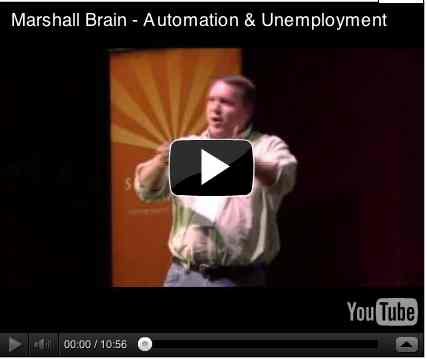
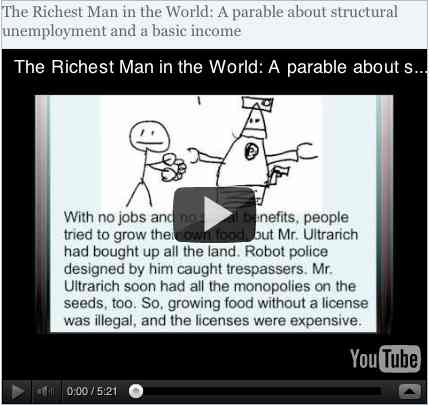
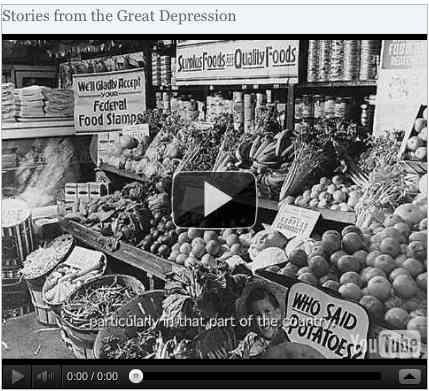
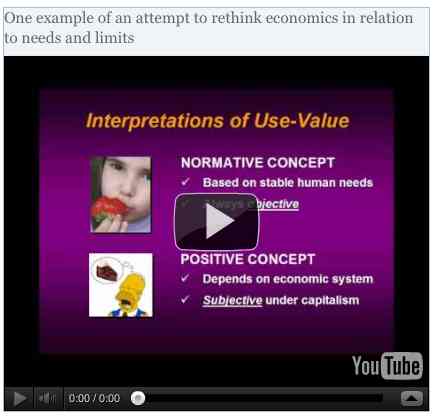


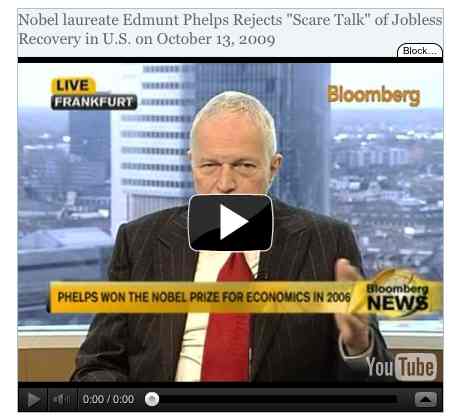
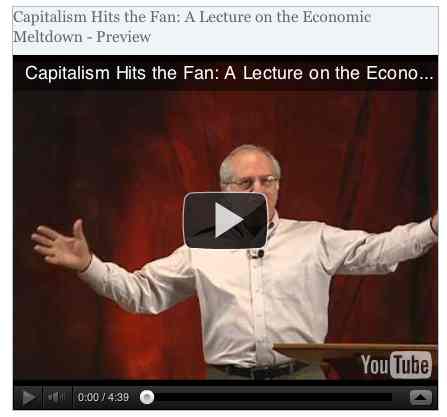

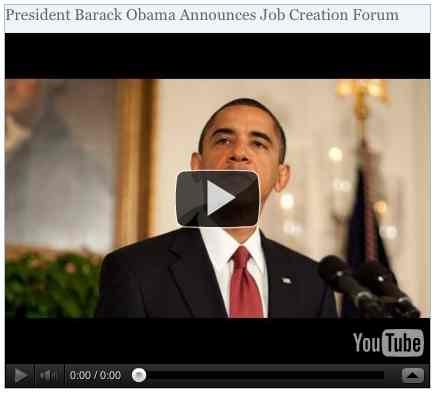

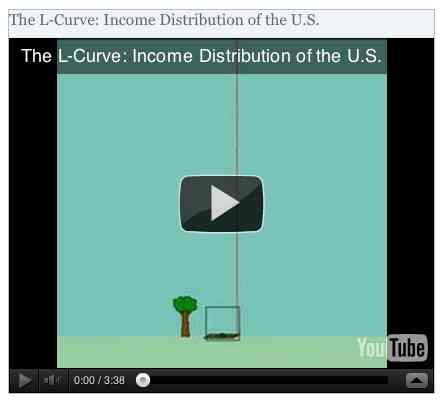
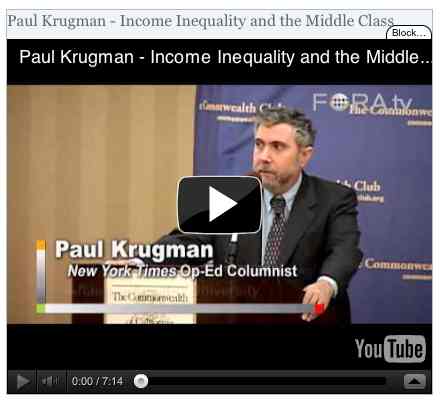
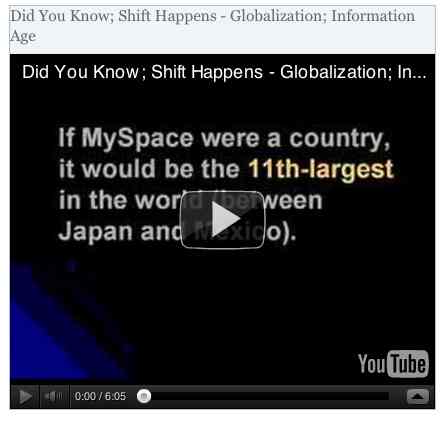
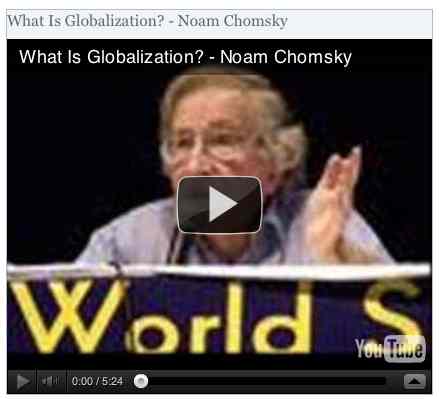




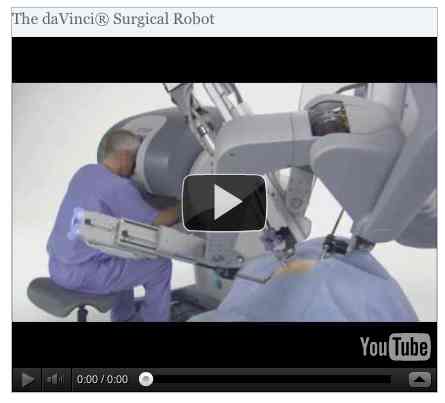







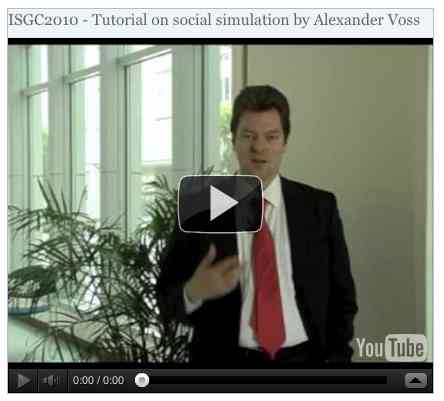


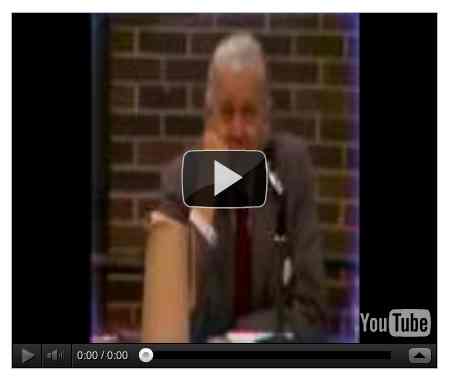
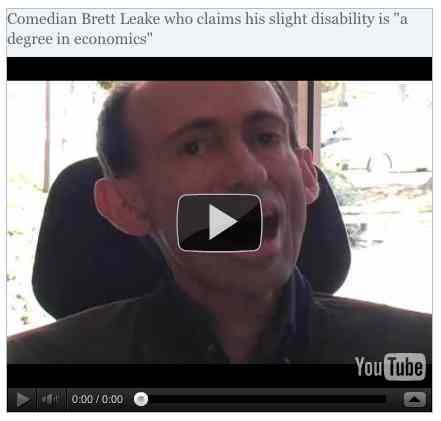

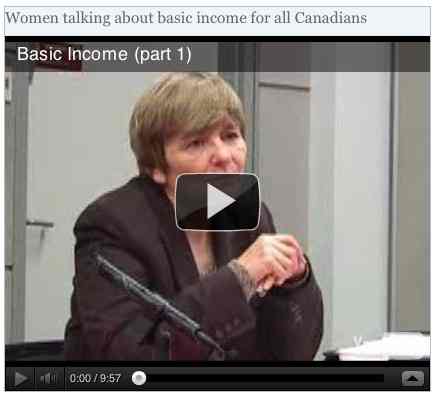






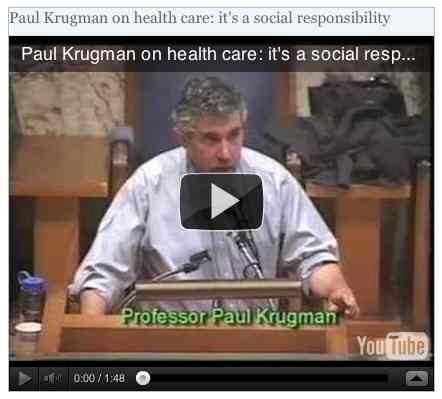








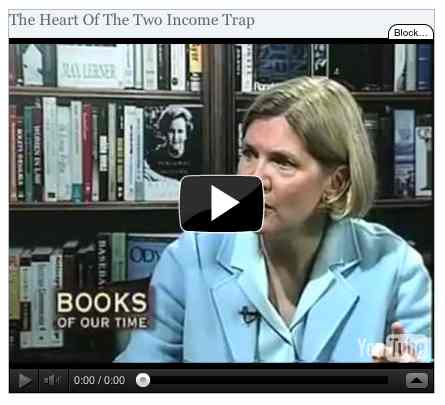






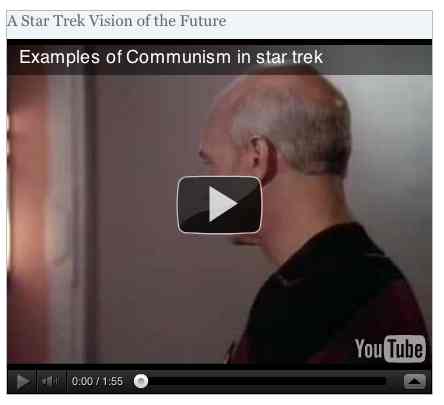

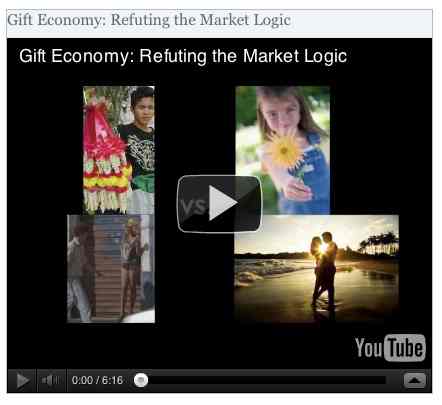

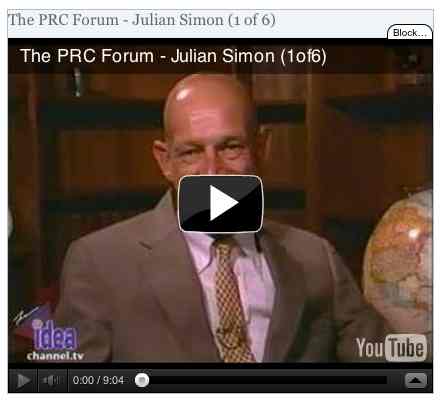

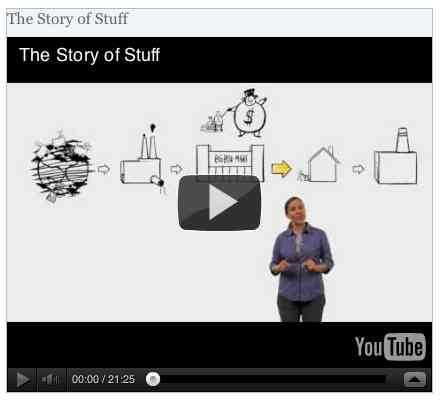



Great Subject but needs to be paired down
I agree with the basic ideas presented here and think its a very important subject. I want to begin to promote these ideas but there's too much junk here. It needs to be tightened up and made more accessible to the average reader.
David O'Leary - May 4, 2011Thanks for the comment. Here is a distillation of many of the core ideas that is much shorter:
Paul Fernhout - May 4, 2011http://peswiki.com/index.php/OS:Economic_Transformation
This knol page also takes a very long time to load with all the embedded youtube videos, so I agree it could all be better organized.